a16z 2025 Report: $4 Trillion Market Cap Record, the First Year of Global Asset On-Chain
It is time to upgrade the financial system, rebuild global payment channels, and create the internet that the world deserves.
Original Title: State of Crypto 2025: The year crypto went mainstream
Original Authors: Daren Matsuoka, Robert Hackett, Eddy Lazzarin, Jeremy Zhang, Stephanie Zinn, a16z
Translated by: xiaozou, Jinse Finance
The world is going fully on-chain.
When we released our first crypto industry report, the sector was still in its adolescence. At that time, the total crypto market cap was only half of what it is today, blockchain speeds were slower, costs were higher, and stability was lacking.
Over the past three years, crypto builders have endured market crashes and regulatory uncertainty, yet have continued to drive major infrastructure upgrades and technological breakthroughs. These efforts have brought us to the present—a historic moment when crypto assets are becoming an important part of the modern economy.
The main theme of crypto in 2025 is industry maturation. In short, the crypto world has grown up:
Traditional financial giants (Visa, BlackRock, Fidelity, JPMorgan) and tech-native challengers (PayPal, Stripe, Robinhood) have all launched crypto products;
Blockchain transaction throughput has surpassed 3,400 transactions per second (a more than 100-fold increase in five years);
Stablecoins support annual transaction volumes of $46 trillion (adjusted to $9 trillion), rivaling Visa and PayPal;
Bitcoin and Ethereum exchange-traded products have surpassed $175 billion in scale.
This year’s report delves into industry transformation: from institutional adoption and the rise of stablecoins to the integration of crypto and artificial intelligence. For the first time, we are introducing a crypto data dashboard to track industry evolution through key metrics.
Below are the core points of this article:
· The crypto market has become large-scale, globalized, and continues to grow;
· Financial institutions are fully embracing crypto assets;
· Stablecoins are entering the mainstream;
· The resilience of the U.S. crypto ecosystem has reached a historic peak;
· The global on-chain process is accelerating;
· Blockchain infrastructure is approaching a maturity tipping point;
· Deep integration of crypto and artificial intelligence technologies.
1. The Crypto Market Has Become Large-Scale, Globalized, and Continues to Grow
In 2025, the total crypto market cap surpassed the $4 trillion mark for the first time, demonstrating an overall industry leap. The number of crypto mobile wallet users surged 20% year-on-year, reaching a record high. The dramatic shift from regulatory resistance to policy support, combined with the accelerated implementation of technologies such as stablecoins and tokenization of traditional financial assets, will define the trajectory of the next cycle.
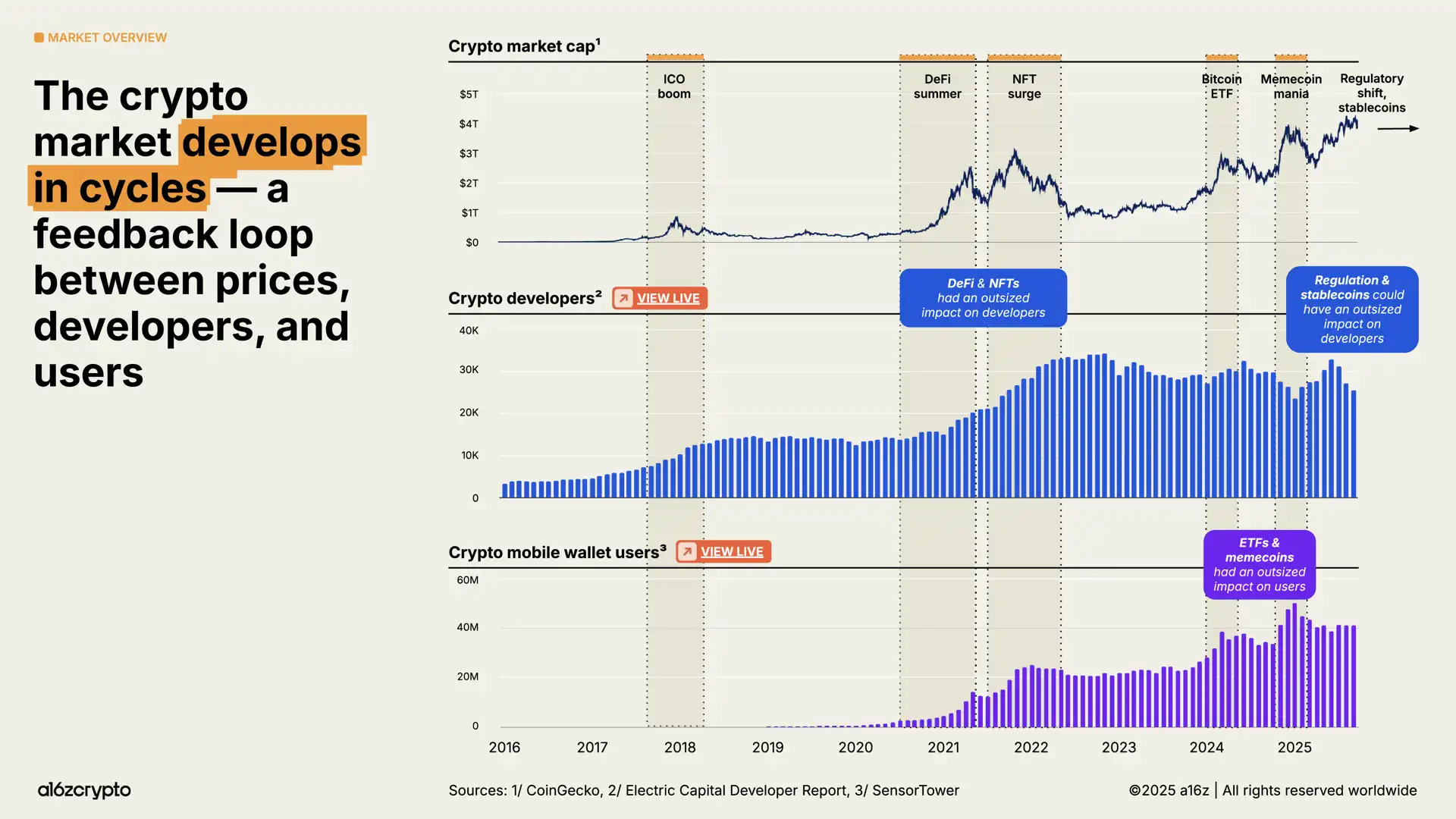
According to our analysis based on updated methodology, there are currently about 40 million to 70 million active crypto users worldwide, an increase of about 10 million from last year.
This figure accounts for only a small proportion of the world’s 716 million crypto asset holders (a 16% year-on-year increase) and is far lower than the approximately 181 million monthly active on-chain addresses (an 18% year-on-year decrease).
The gap between passive holders (those who own crypto assets but do not transact on-chain) and active users (those who regularly transact on-chain) reveals a key opportunity for crypto builders: how to reach the potential user base that already holds crypto assets but has not yet participated in on-chain activities.
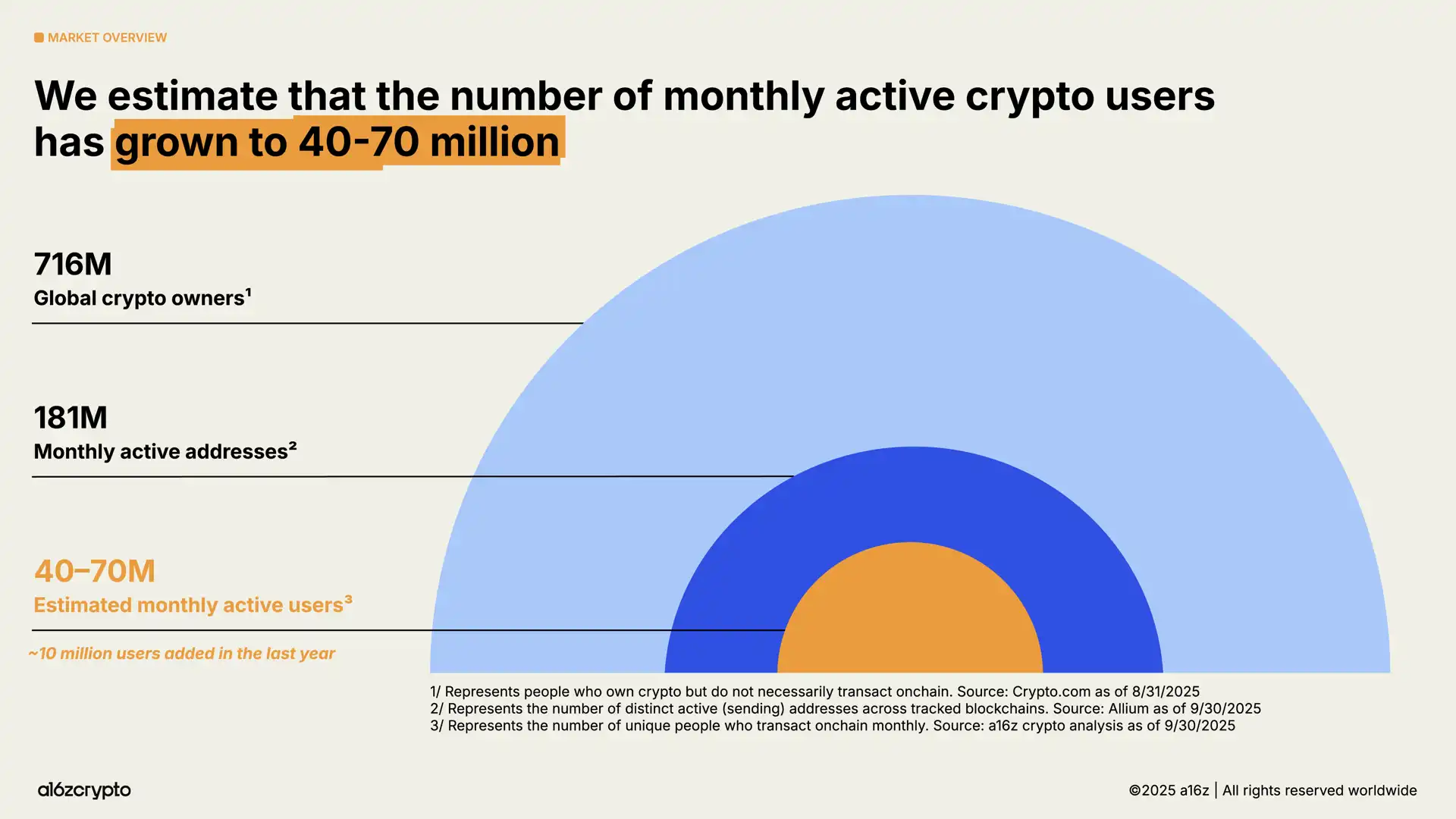
So where are these crypto users located? What activities are they engaging in?
The crypto ecosystem is global in nature, but different regions of the world exhibit differentiated usage patterns. As an indicator of on-chain activity, mobile wallet usage has grown fastest in emerging markets such as Argentina, Colombia, India, and Nigeria (especially in Argentina, where mobile wallet usage has surged 16-fold over the past three years amid a worsening currency crisis).
Meanwhile, our analysis of the geographic sources of token-related web traffic shows that token interest indicators are more skewed toward developed countries. Compared to users in developing countries, activities in countries like Australia and South Korea may be more focused on trading and speculation.
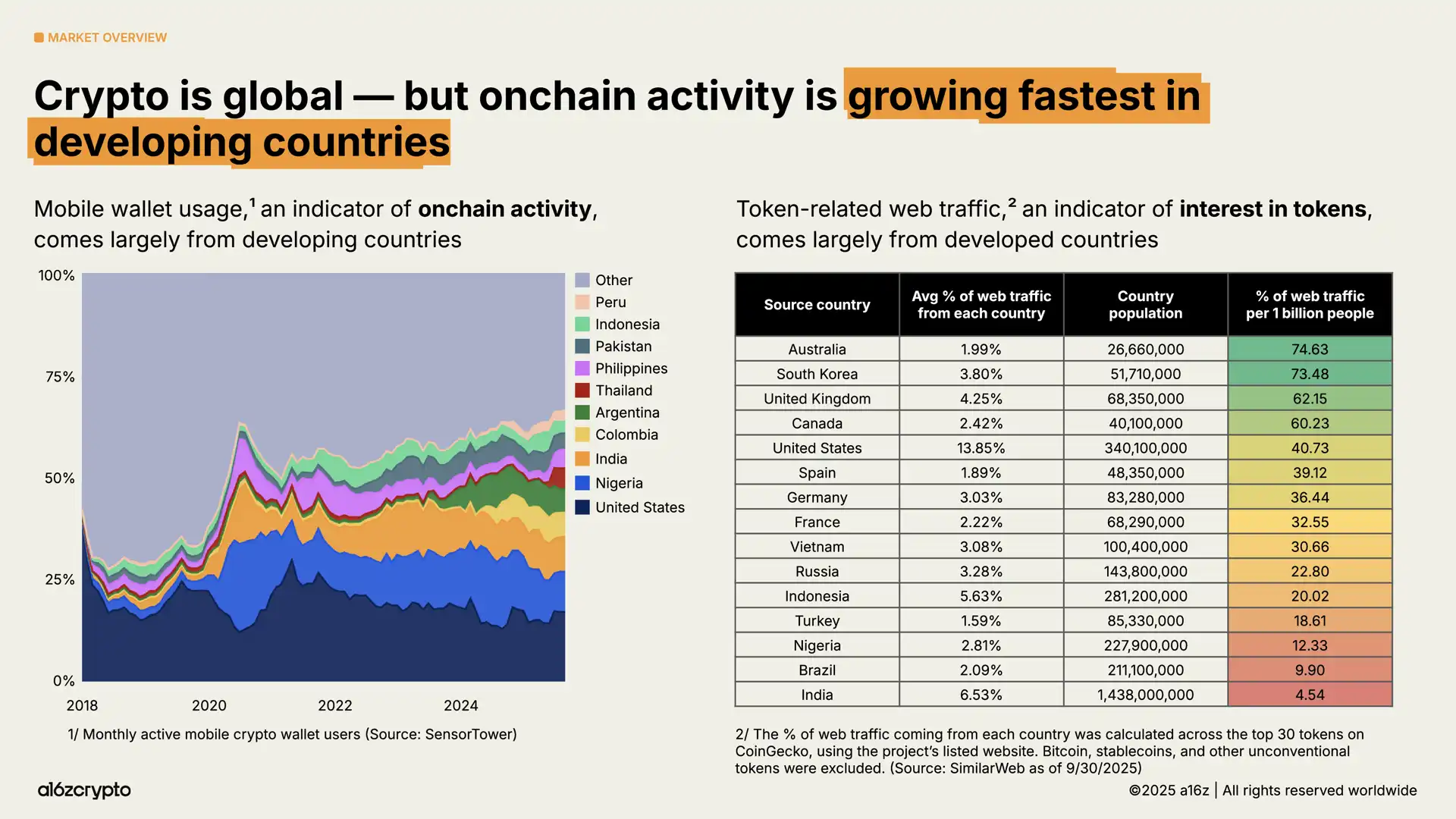
Bitcoin (which still accounts for more than half of the total crypto market cap) is favored by investors as a store of value, reaching a historic high above $126,000. Meanwhile, Ethereum and Solana have recovered most of the ground lost after the 2022 crash.
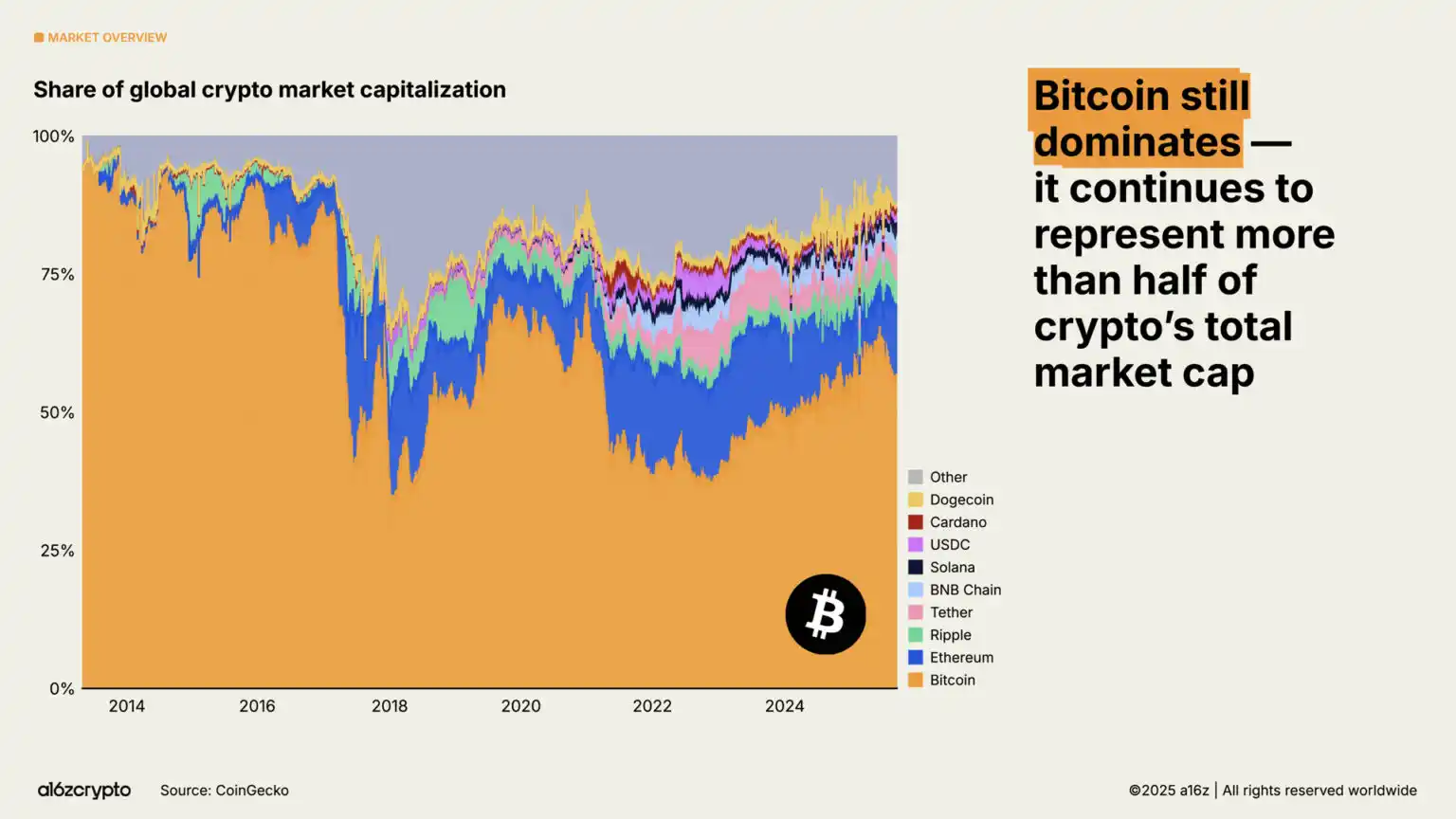
As blockchains continue to scale, fee markets mature, and new applications emerge, certain metrics are becoming increasingly important. "Real economic value" is one of them—it measures the scale of fees users actually pay to use blockchains. Currently, Hyperliquid and Solana account for 53% of revenue-generating economic activity, marking a significant shift from the earlier dominance of Bitcoin and Ethereum.
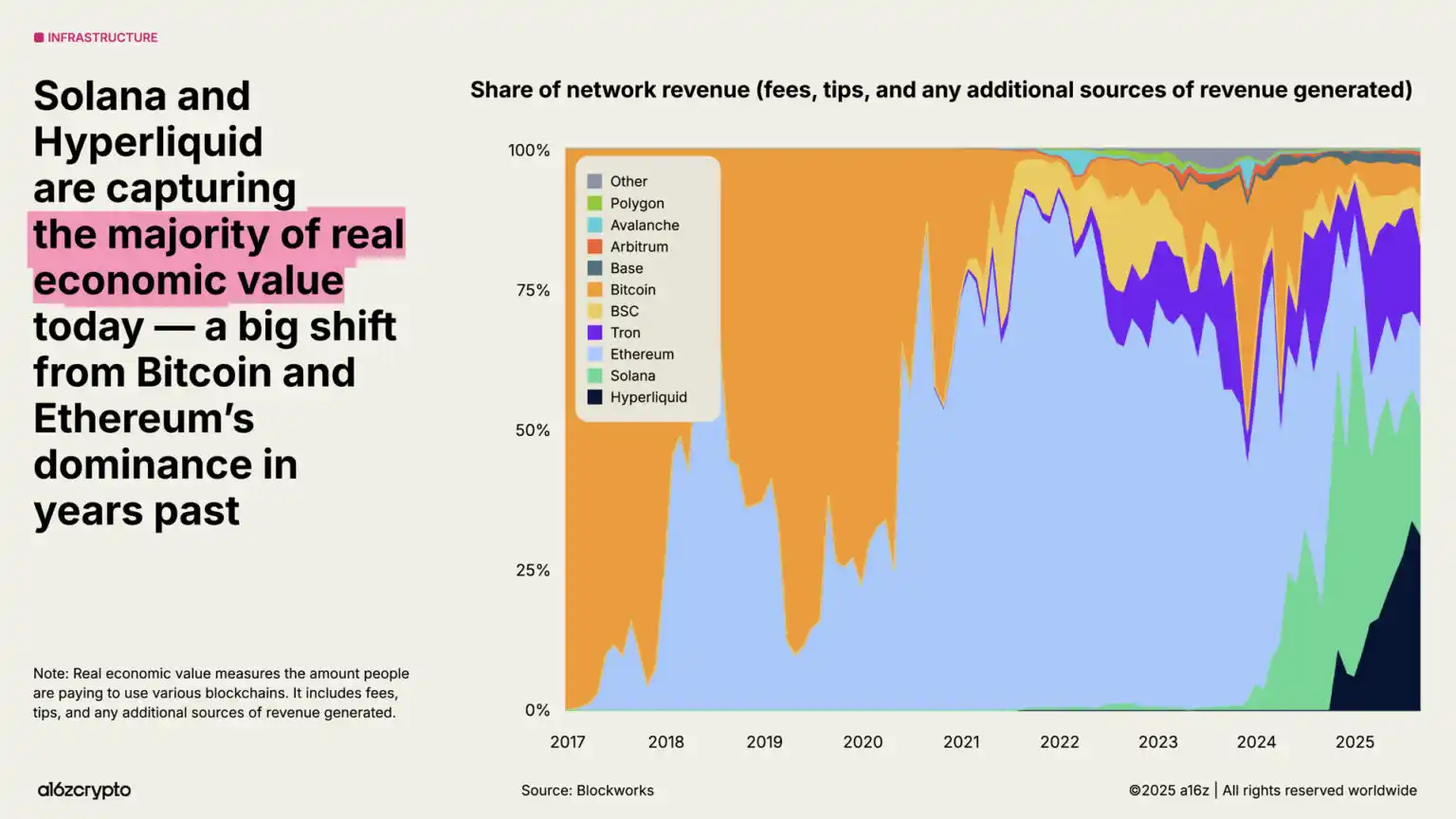
From a developer ecosystem perspective, the crypto world still presents a multi-chain landscape, with Bitcoin, Ethereum and its Layer 2 networks, and Solana forming the three core developer hubs. In 2025, Ethereum and its Layer 2 networks have become the top choice for new developers, while Solana is one of the fastest-growing ecosystems—developer interest has increased by 78% over the past two years. This data comes from a16z crypto investment team's survey of entrepreneurs' preferred development platforms.
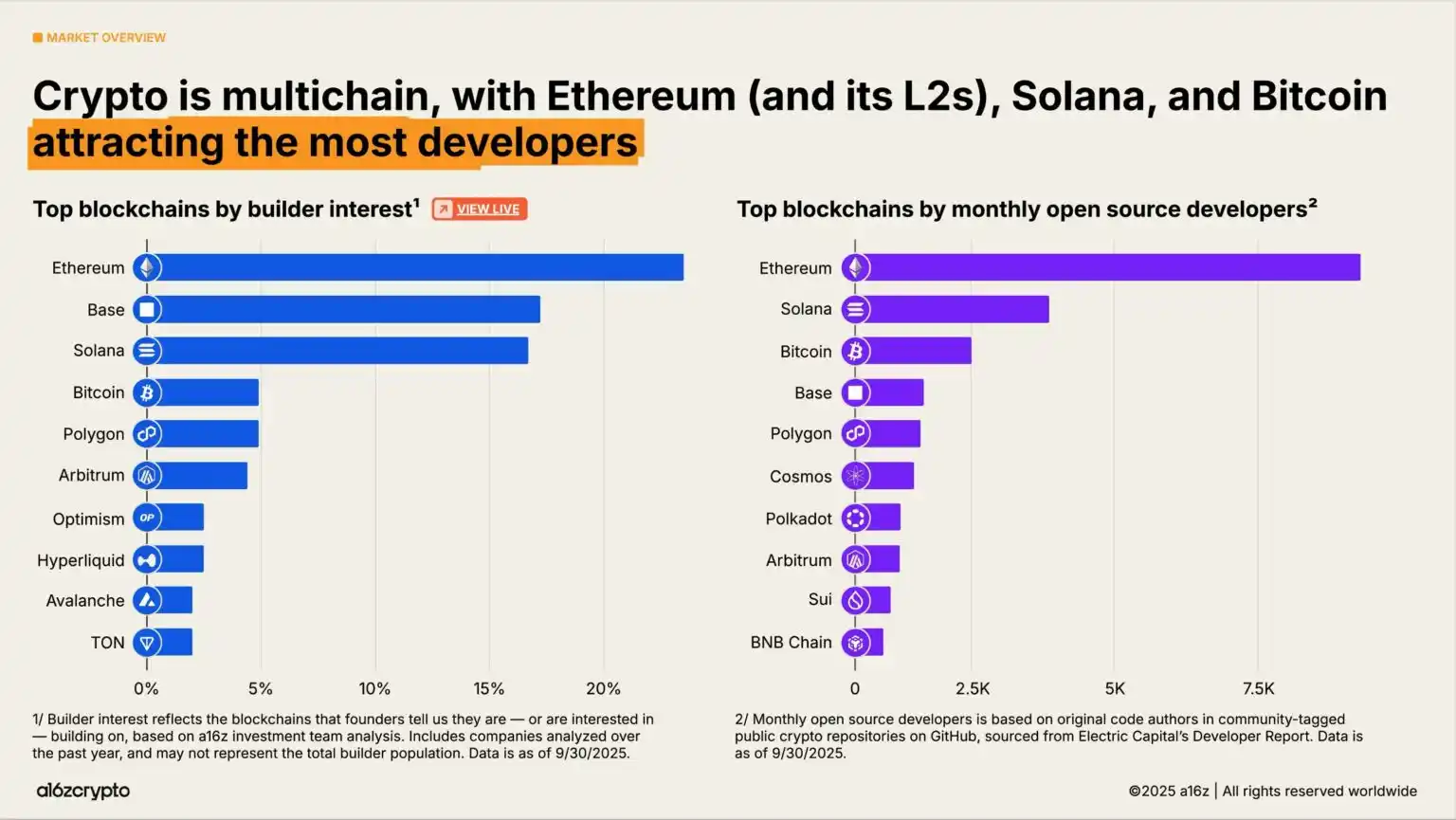
2. Financial Institutions Fully Embrace Crypto Assets
2025 can be called the inaugural year of institutional adoption. Just five days after last year's "State of Crypto" report announced that stablecoins had achieved product-market fit, Stripe announced the acquisition of stablecoin infrastructure platform Bridge, marking the start of traditional financial companies publicly deploying stablecoins.
Months later, Circle’s $10 billion IPO marked stablecoin issuers’ official entry into the ranks of mainstream financial institutions. In July, the bipartisan "GENIUS Act" was formally enacted, providing clear action guidelines for builders and institutions. Since then, the frequency of "stablecoin" mentions in SEC filings has increased by 64%, and announcements of deployments by major financial institutions have surged.
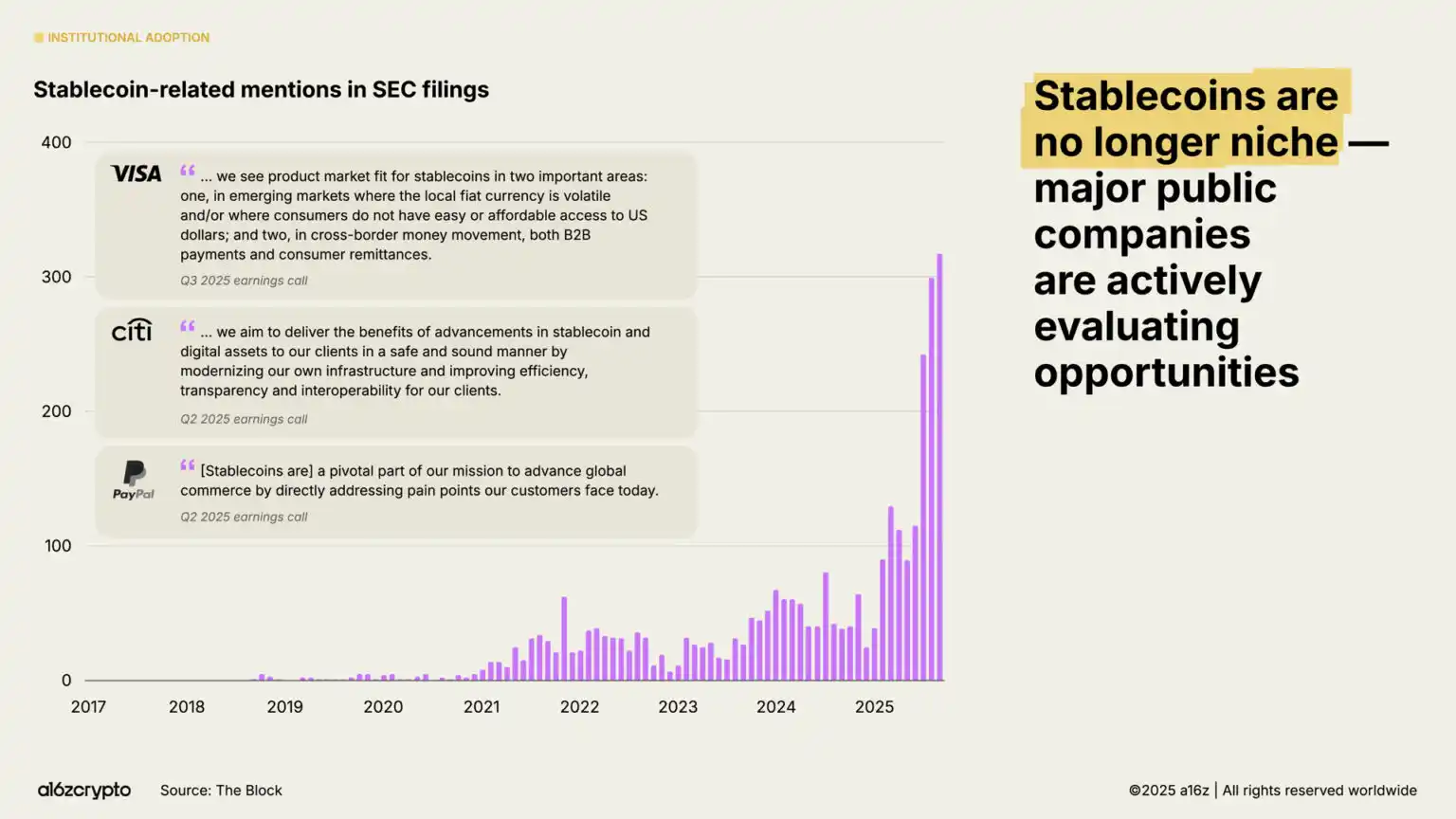
Institutional applications are accelerating. Traditional financial institutions such as Citigroup, Fidelity, JPMorgan, Mastercard, Morgan Stanley, and Visa have begun (or plan) to directly offer crypto products to consumers, enabling them to buy, sell, and hold digital assets as well as traditional tools such as stocks and exchange-traded products. Meanwhile, platforms like PayPal and Shopify are doubling down on payments, building infrastructure for daily transactions between merchants and consumers.
In addition to directly offering products, major fintech companies such as Circle, Robinhood, and Stripe are actively developing or have announced plans to develop new blockchains focused on payments, real-world assets, and stablecoins. These initiatives may drive more payment flows on-chain, promote enterprise applications, and ultimately build a larger, faster, and more globalized financial system.
These companies have enormous distribution networks. If development continues, crypto technology is likely to be fully integrated into the financial services we use every day.
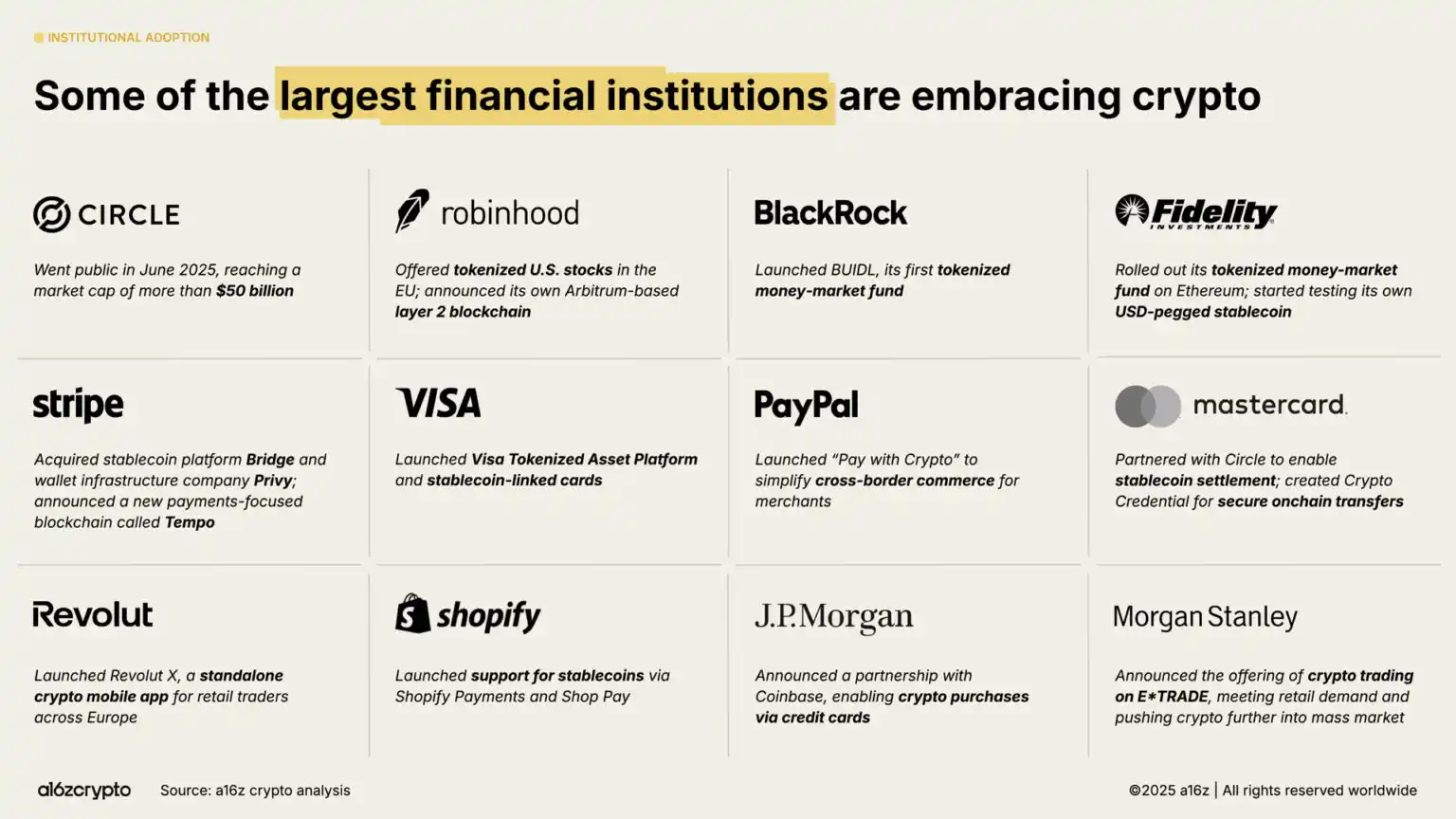
Exchange-traded products have become another key driver of institutional investment, with on-chain crypto asset holdings surpassing $175 billion, a 169% surge from $65 billion a year ago.
BlackRock’s iShares Bitcoin Trust is hailed as the most actively traded Bitcoin exchange-traded product in history, and the recently launched Ethereum exchange-traded products have also seen significant inflows in recent months. (Note: Although often referred to as exchange-traded funds, these products are actually registered as exchange-traded products with the SEC via S-1 filings, indicating their underlying assets do not include securities.)
These products significantly lower the investment threshold for crypto assets, opening the door for large-scale institutional capital that has historically remained on the industry’s sidelines.
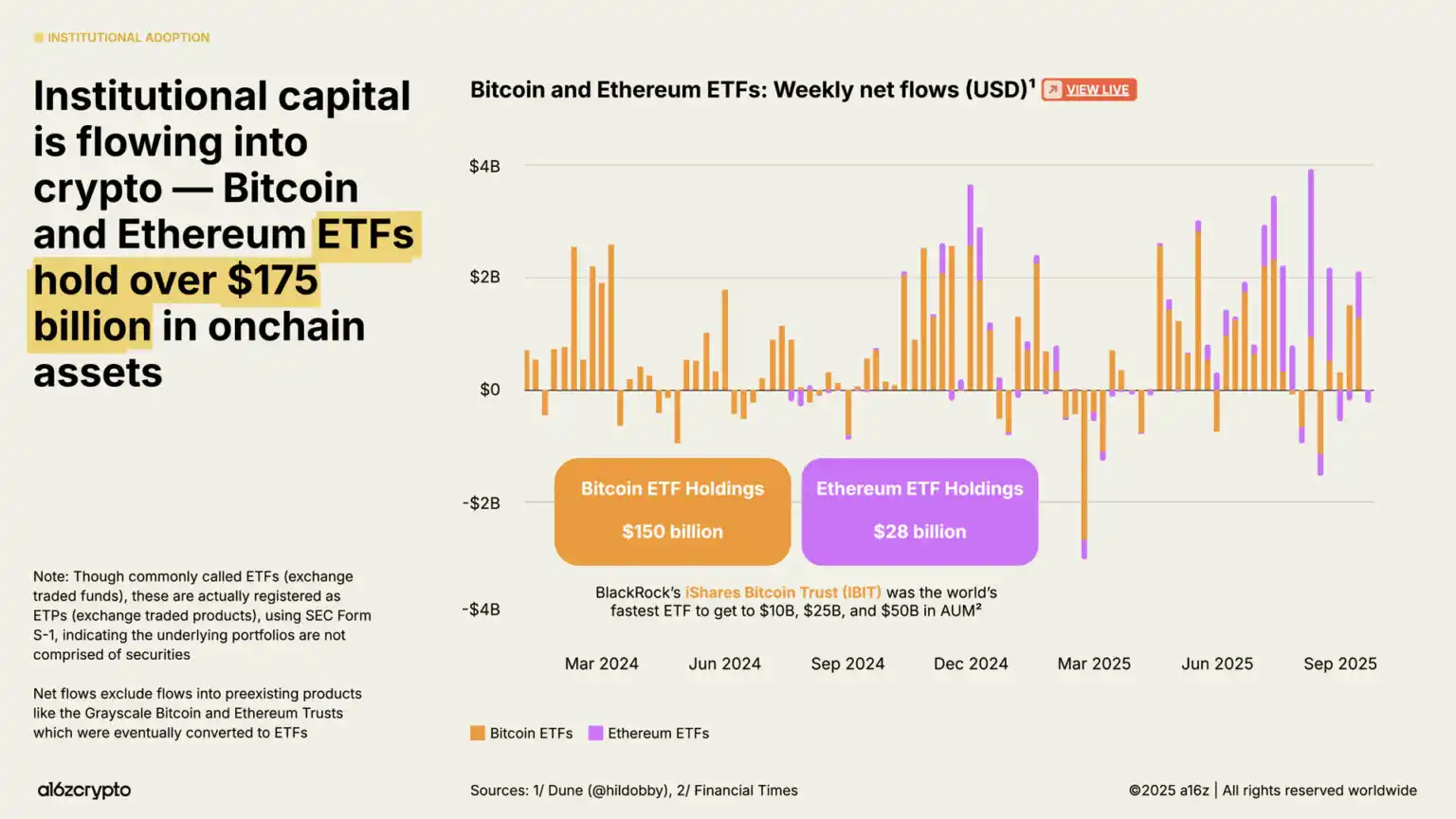
Publicly traded "digital asset reserve" companies—which hold crypto assets on their balance sheets (similar to entities holding cash in corporate treasuries)—currently hold about 4% of the circulating supply of Bitcoin and Ethereum. These digital asset reserve companies and exchange-traded products together now hold about 10% of the circulating supply of Bitcoin and Ethereum.
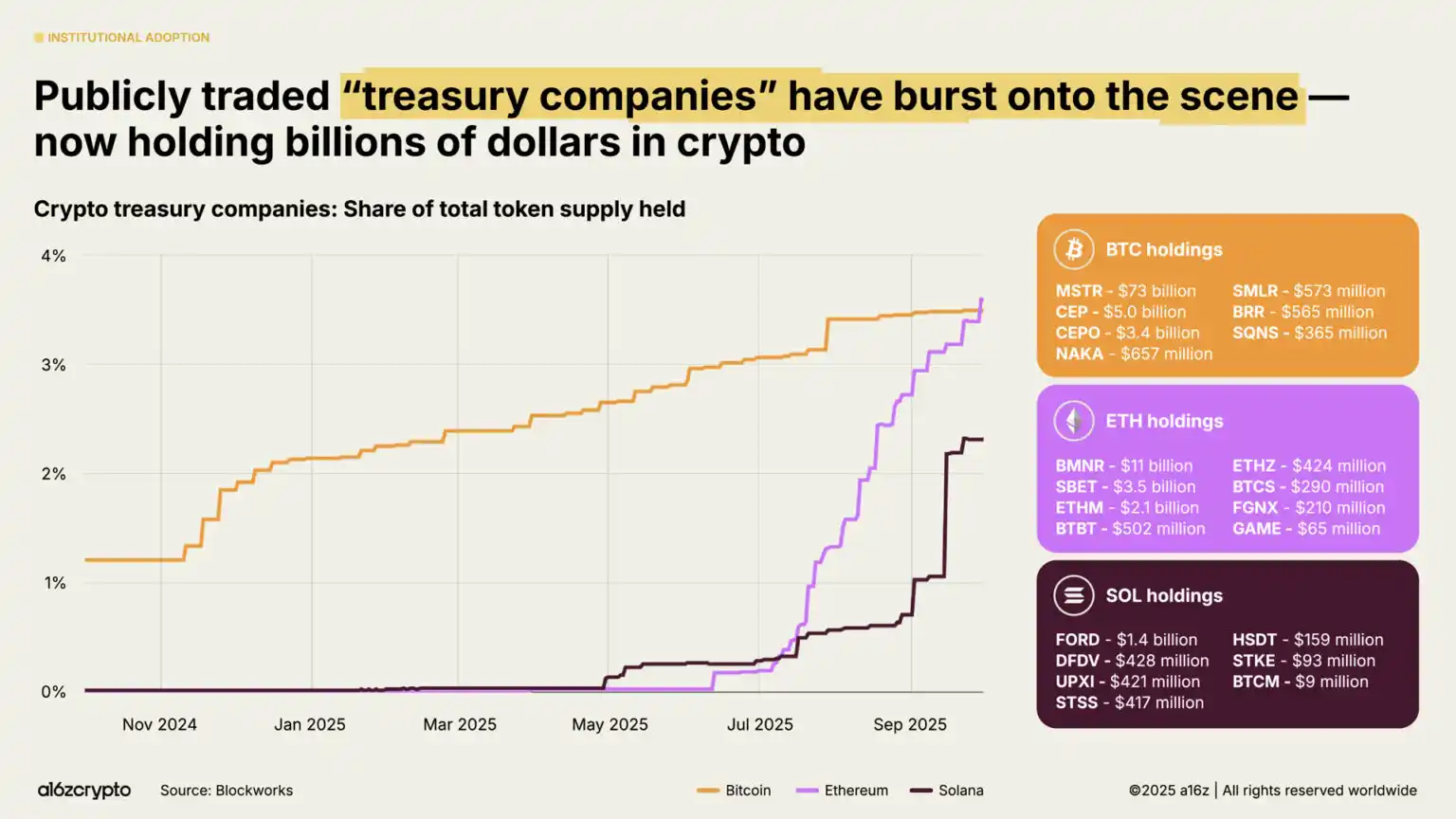
3. Stablecoins Enter the Mainstream
Nothing better demonstrates the maturity of the crypto market in 2025 than the rise of stablecoins. In previous years, stablecoins were mainly used to settle speculative crypto trades, but in the past two years, they have become the fastest and lowest-cost way to transfer dollars globally—processing millions of transactions per second, with per-transaction costs of less than a cent, covering the vast majority of regions worldwide.
This year, stablecoins have become the backbone of the on-chain economy.
Over the past year, the total transaction volume of stablecoins reached $46 trillion, a 106% year-on-year increase. Although this mainly represents capital flows (unlike card networks’ retail payments), the scale is three times that of Visa and is approaching the ACH network that connects the entire U.S. banking system.
After adjustment (excluding bot and wash trading data), the real transaction volume of stablecoins over the past 12 months was $9 trillion, an 87% year-on-year increase, more than five times PayPal’s volume and over half the scale of Visa.
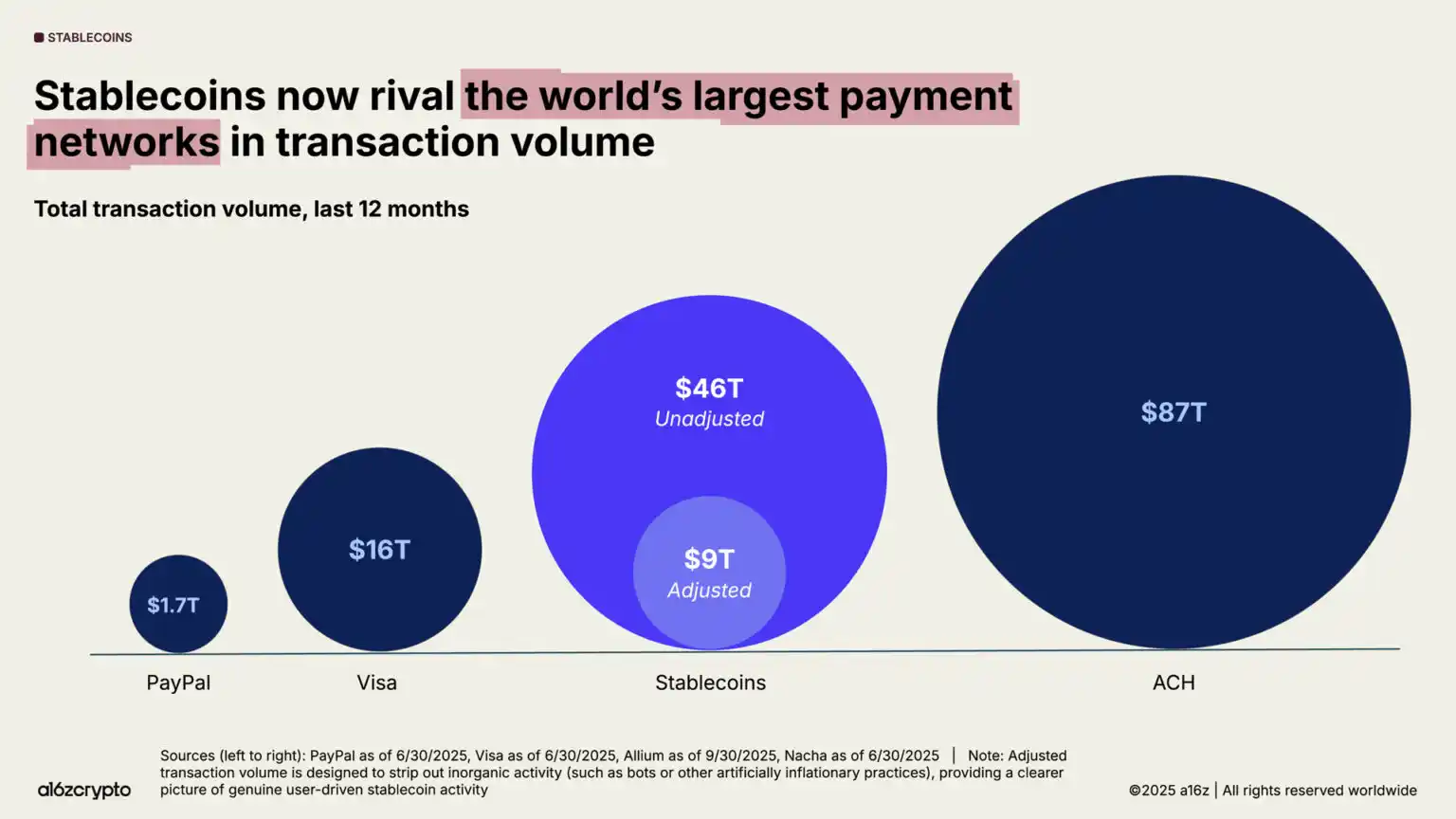
Adoption is accelerating. Adjusted monthly stablecoin transaction volume has soared to a record high, reaching nearly $1.25 trillion in September 2025 alone.
Notably, this activity is only weakly correlated with overall crypto trading volume—indicating that stablecoins are being used for non-speculative purposes, and more importantly, confirming their product-market fit.
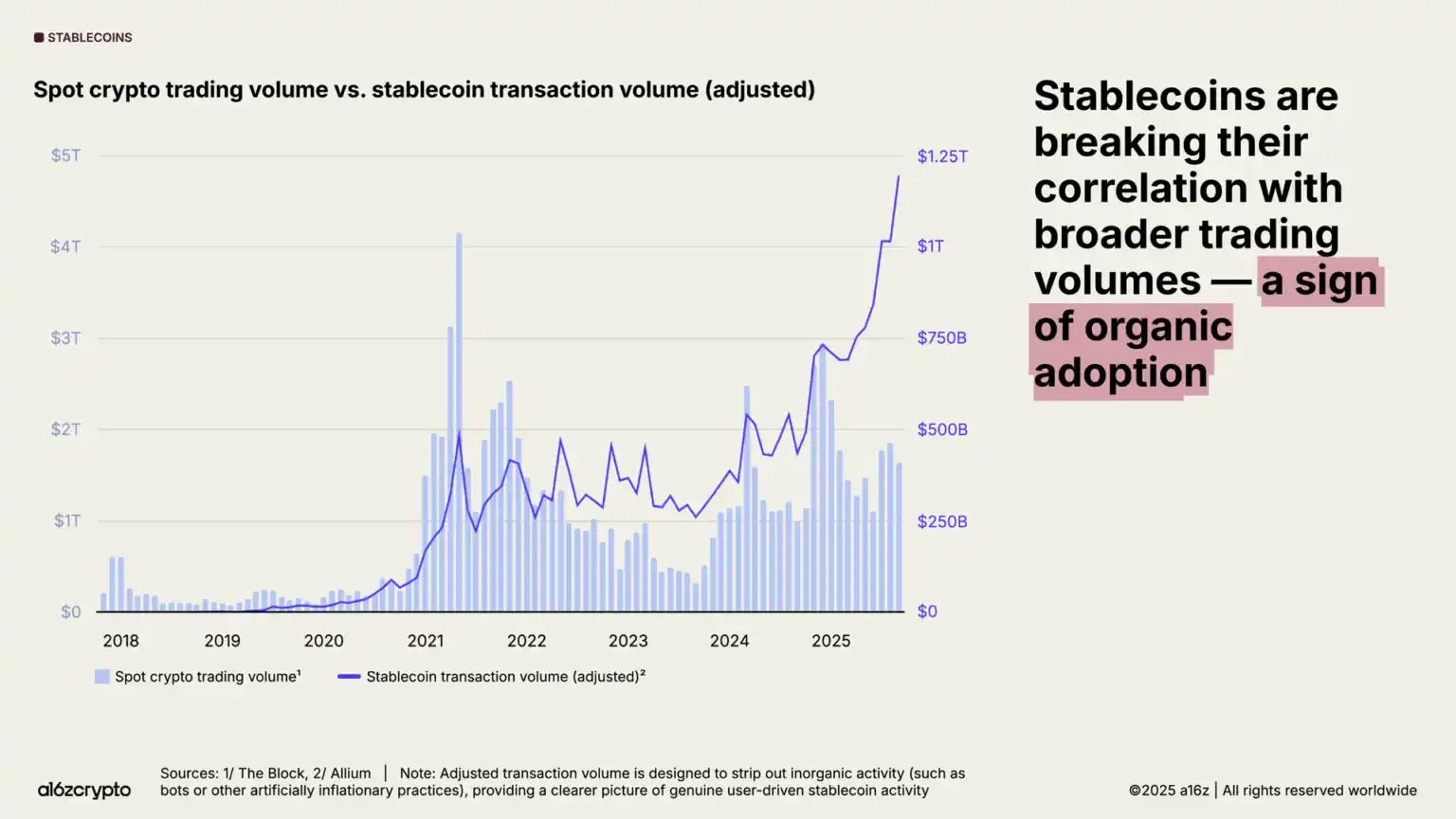
Total stablecoin supply has also hit a record high, now exceeding $300 billion.
The market is dominated by leading stablecoins: Tether and USDC account for 87% of total supply. In September 2025, stablecoin transaction volume (adjusted) on Ethereum and Tron blockchains reached $772 billion, accounting for 64% of all transactions. Although these two issuers and blockchains dominate stablecoin activity, new blockchains and issuers are also accelerating their growth.
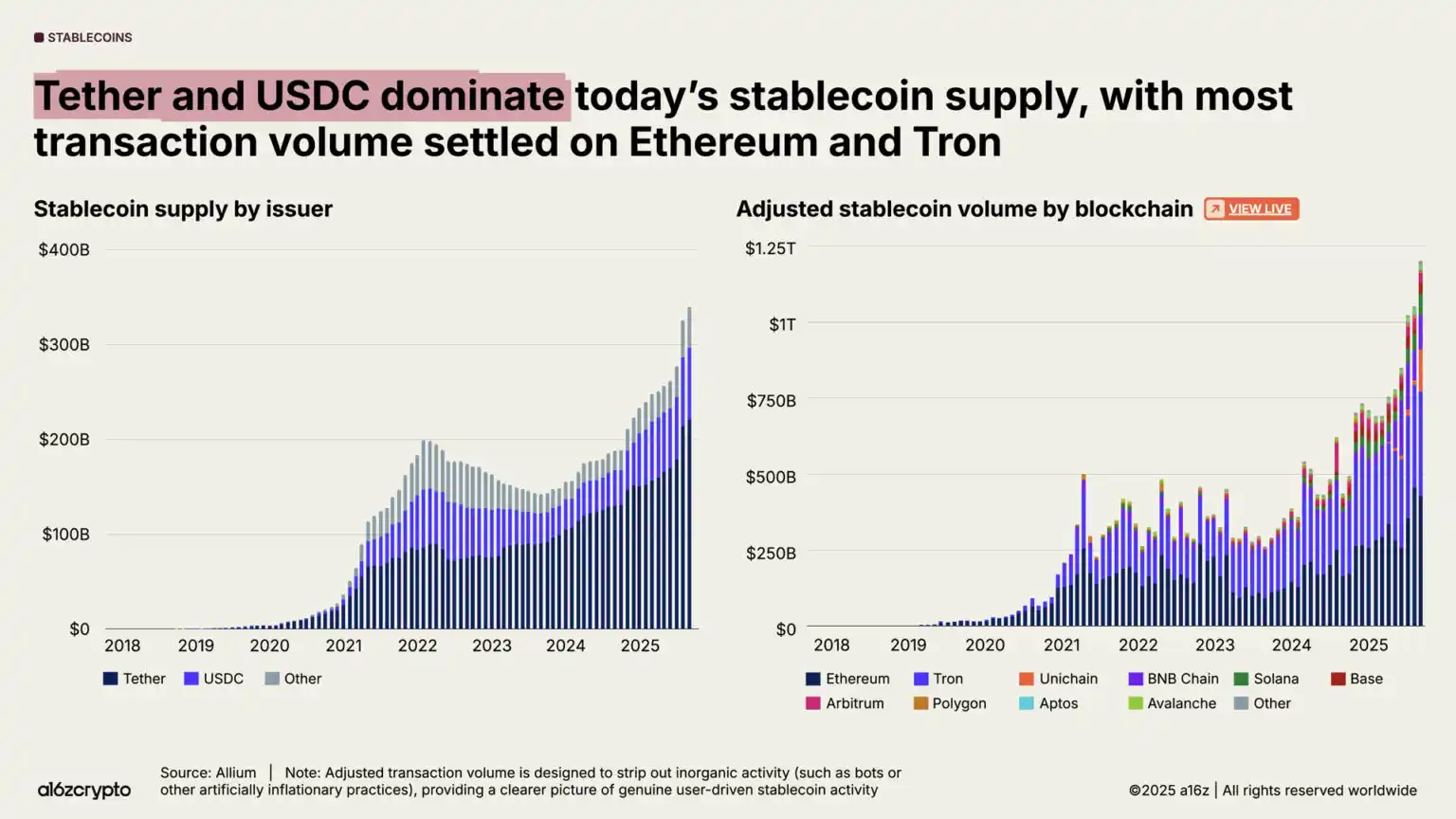
Stablecoins have become a significant force in the global macroeconomy: over 1% of U.S. dollars exist as tokenized stablecoins on public blockchains, and their U.S. Treasury holdings have risen from 20th to 17th place globally. Currently, stablecoins collectively hold over $150 billion in U.S. Treasuries—more than many sovereign nations.
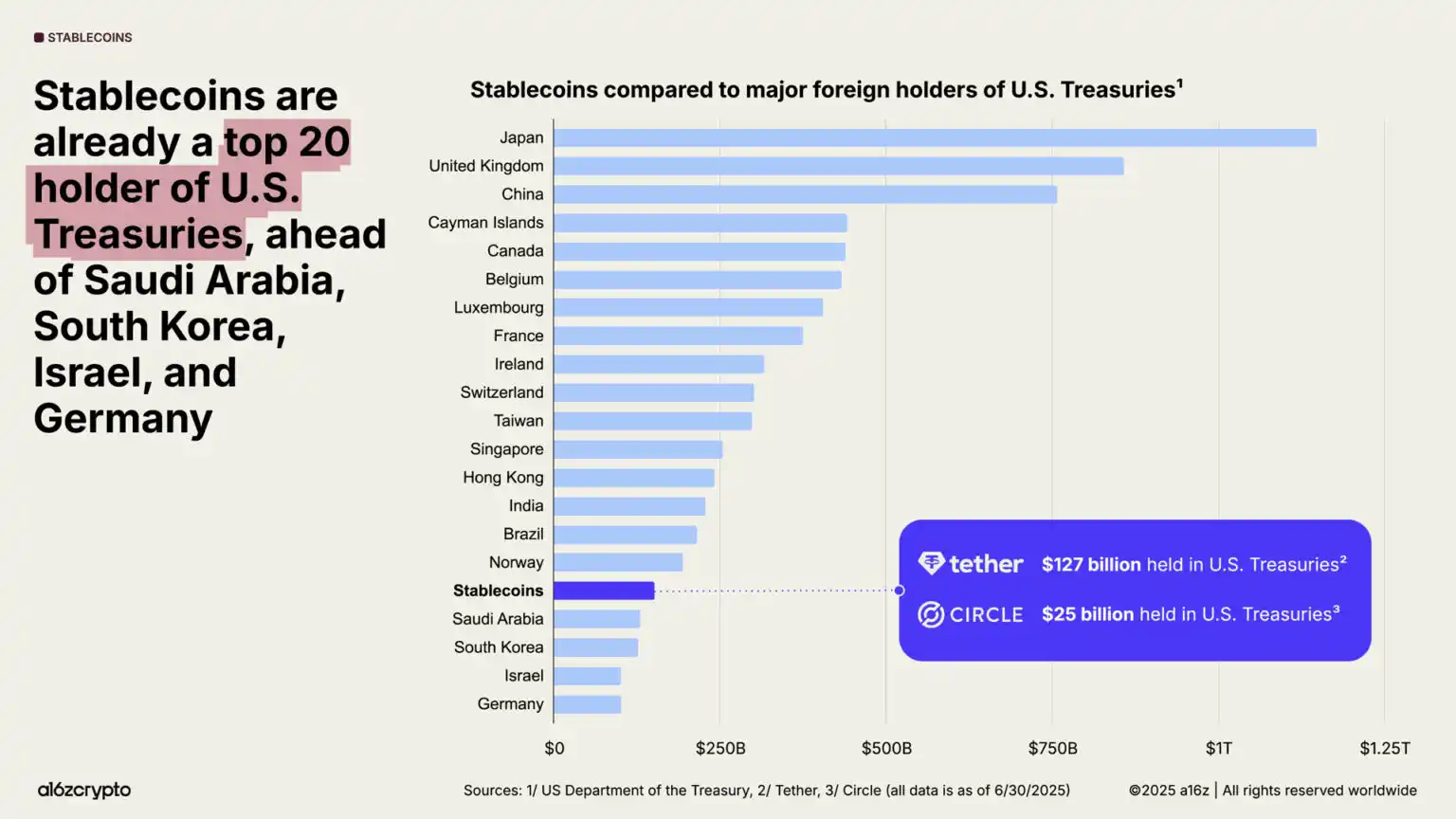
Meanwhile, despite weakening global demand for U.S. Treasuries, national debt continues to surge. For the first time in 30 years, foreign central bank gold reserves have surpassed U.S. Treasury holdings.
But stablecoins are bucking the trend: over 99% of stablecoins are denominated in U.S. dollars, and their scale is expected to grow tenfold to over $3 trillion by 2030, potentially providing a strong and sustainable source of demand for U.S. debt in the coming years.
Even if foreign central banks reduce their holdings of U.S. Treasuries, stablecoins are still consolidating the dollar’s dominance.
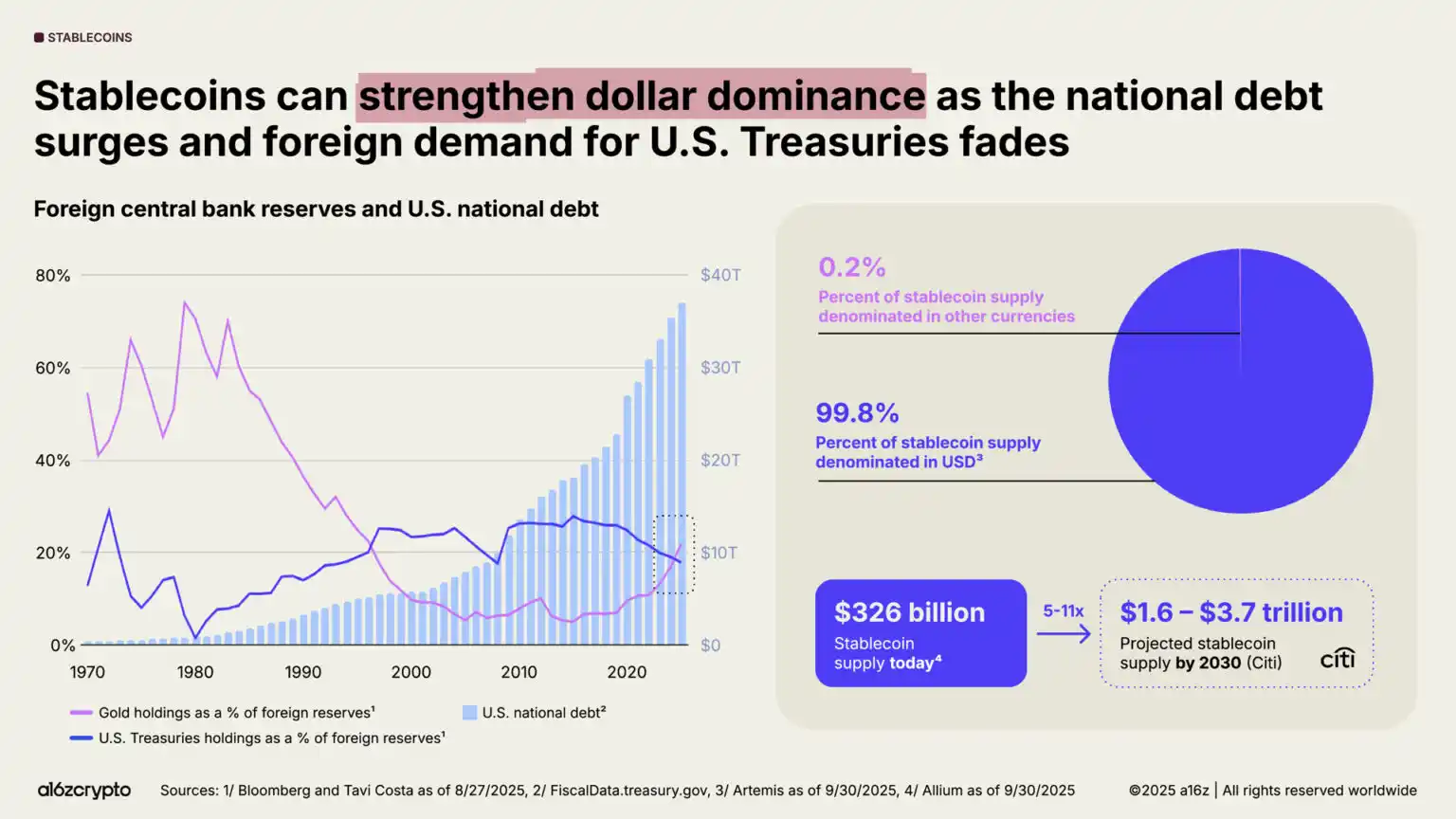
4. The Resilience of the U.S. Crypto Ecosystem Has Reached a Historic Peak
The U.S. has reversed its previous adversarial stance toward crypto, restoring builder confidence.
This year, the passage of the "GENIUS Act" and the approval of the "CLARITY Act" by the House of Representatives mark bipartisan consensus: crypto assets will not only persist in the U.S., but now have the conditions to thrive. Together, these two acts establish a stablecoin regulatory, market structure, and digital asset oversight framework that balances innovation and investor protection. Meanwhile, Executive Order No. 14178 repealed earlier anti-crypto directives and established an interagency working group to modernize federal digital asset policy.
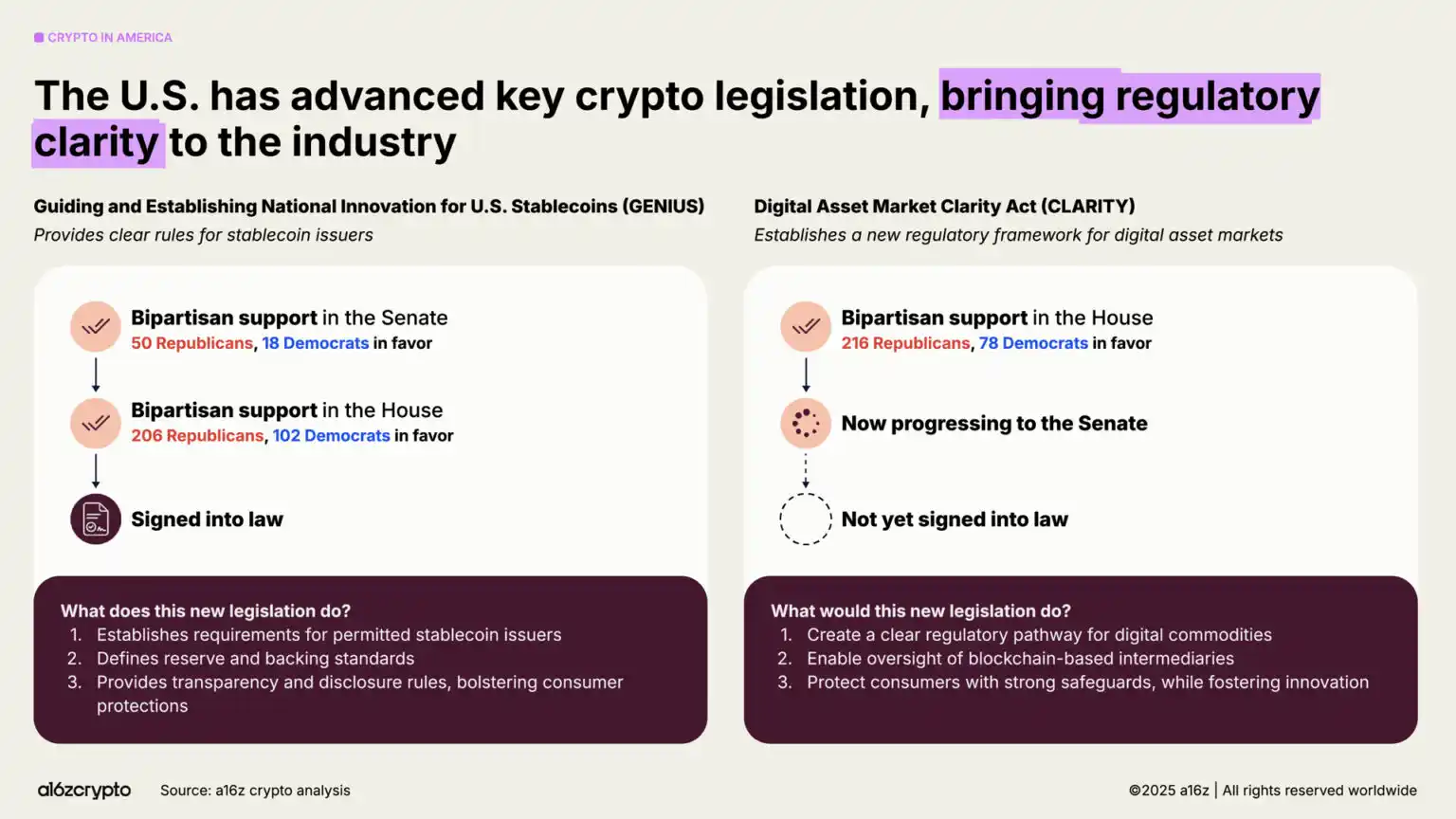
The regulatory environment is paving the way for builders to fully unleash the potential of tokens as new digital primitives—just as websites did for earlier generations of the internet. As regulatory frameworks become clearer, more network tokens will complete economic loops by generating revenue attributable to holders, creating a self-sustaining new economic engine for the internet that allows more users to share in system rewards.
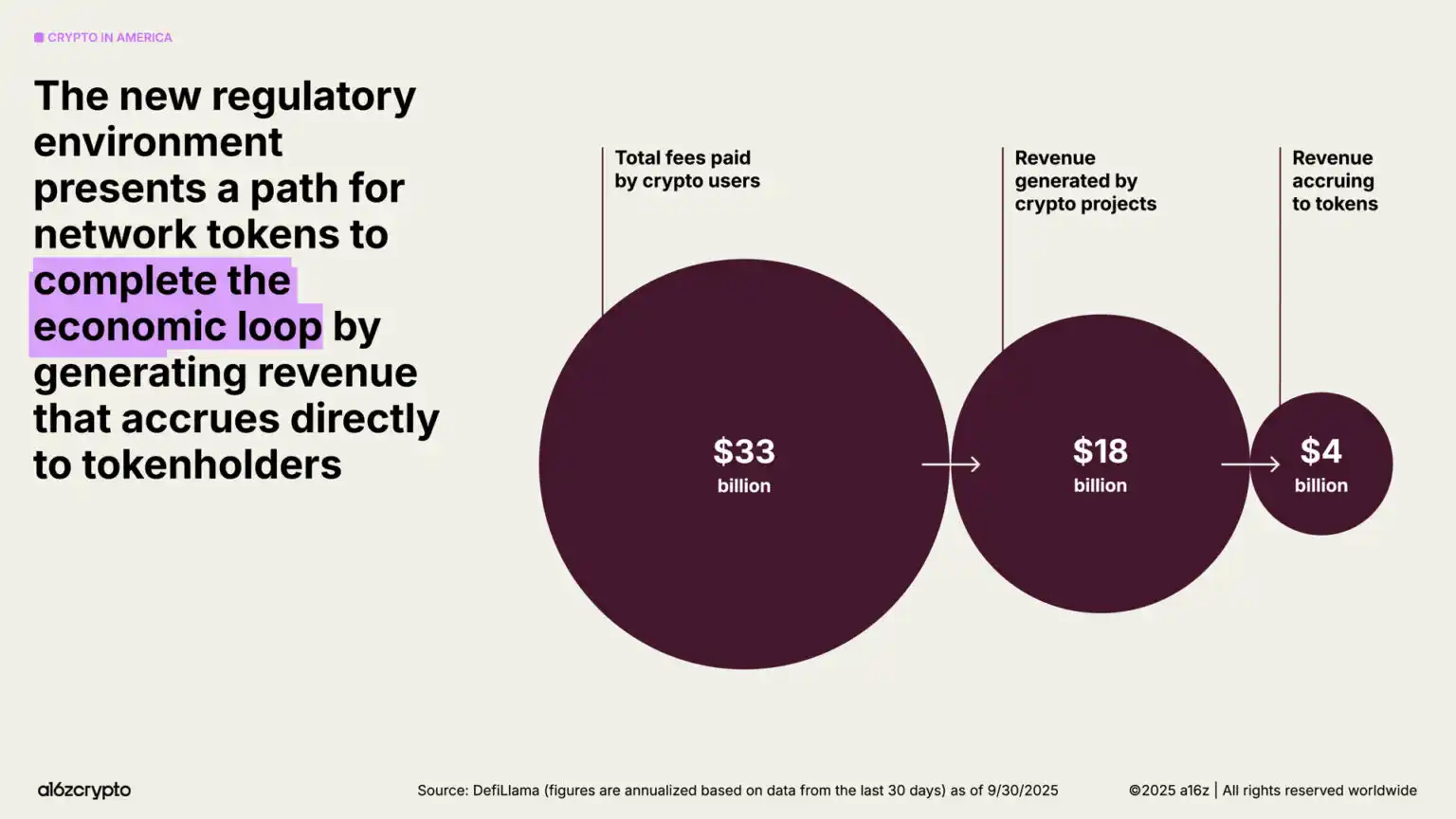
5. The Global On-Chain Process Is Accelerating
What was once a niche testing ground for early adopters has evolved into a diverse on-chain economy with tens of millions of monthly active participants. Today, nearly one-fifth of spot trading volume is executed through decentralized exchanges.
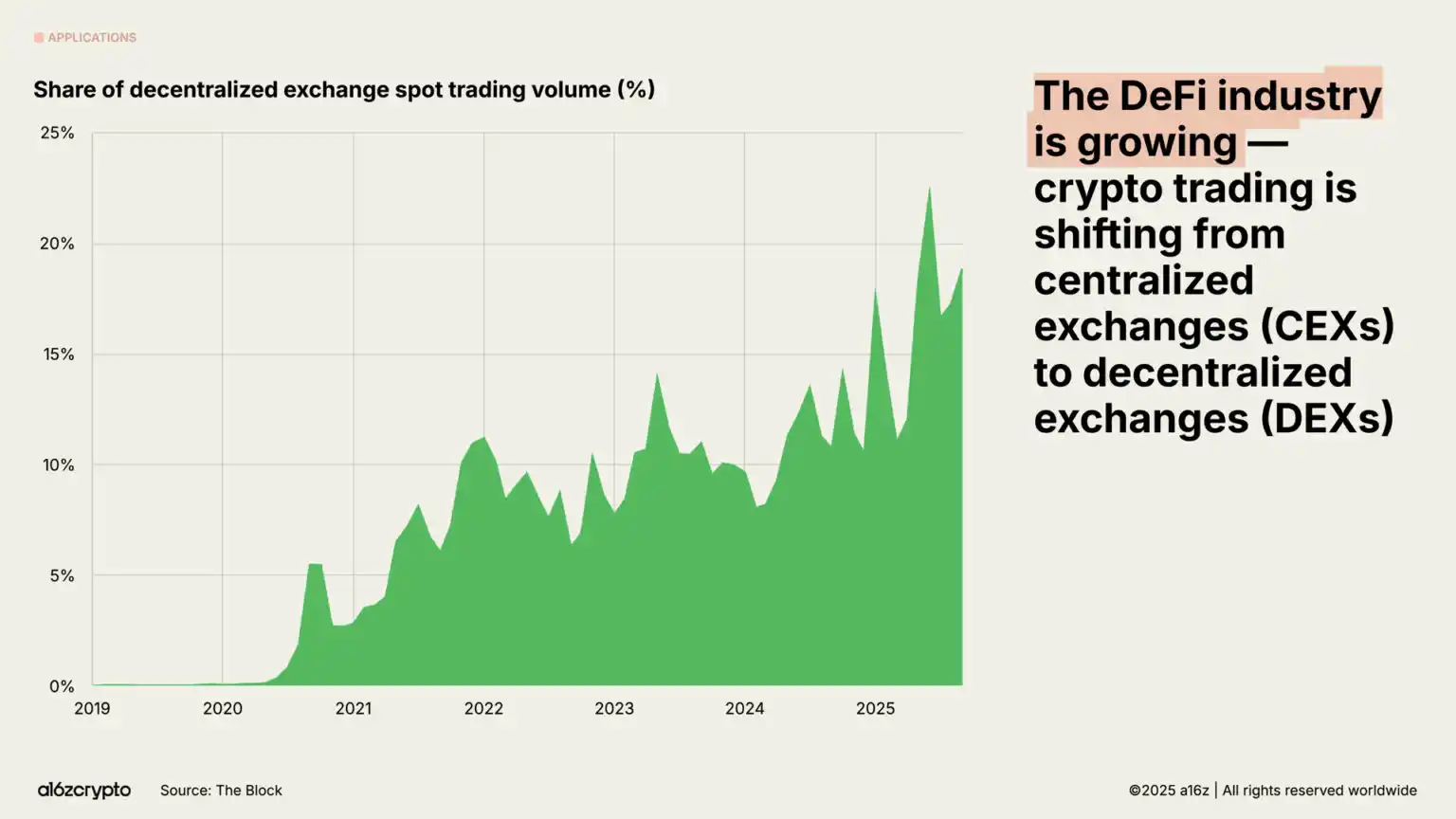
Perpetual contract trading volume has surged nearly eightfold over the past year, experiencing explosive growth among crypto speculators. Decentralized perpetual contract exchanges such as Hyperliquid have processed trillions of dollars in trading volume, generating over $1 billion in annualized revenue this year—comparable to some centralized exchanges.
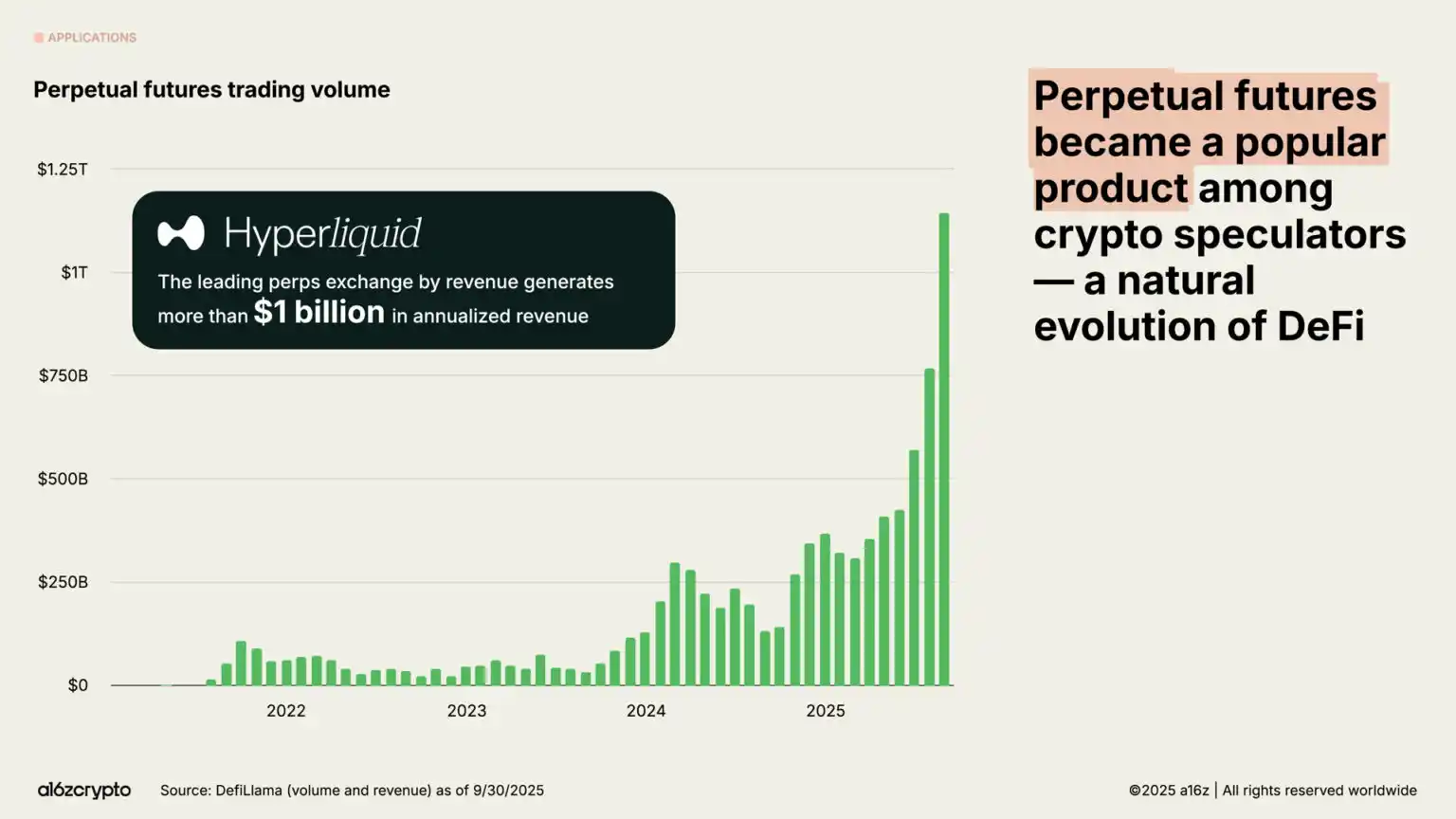
Real-world assets—including U.S. Treasuries, money market funds, private credit, and real estate in tokenized form on-chain—are bridging crypto and traditional finance. The total market size of tokenized RWAs has reached $30 billion, nearly quadrupling over the past two years.
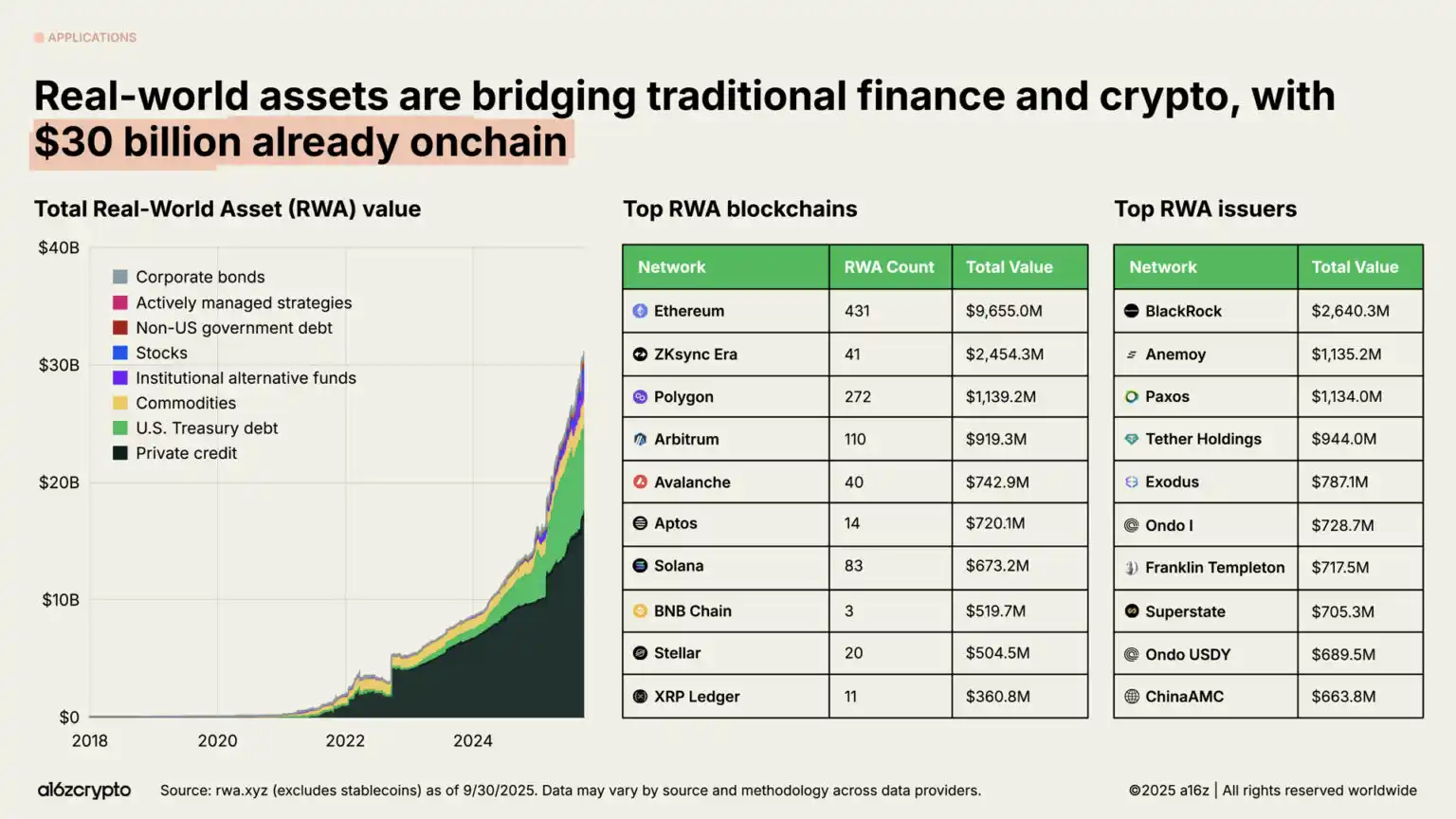
Outside of finance, the most ambitious blockchain frontier in 2025 is DePIN—decentralized physical infrastructure networks.
Just as DeFi restructured the financial system, DePIN is reshaping physical infrastructure such as telecommunications networks, transportation systems, and energy grids. The potential is enormous: the World Economic Forum predicts the DePIN market will reach $3.5 trillion by 2028.
The Helium network is the most representative case. This grassroots-driven wireless network, operated by over 111,000 user-run hotspots, currently provides 5G cellular coverage to 1.4 million daily active users.
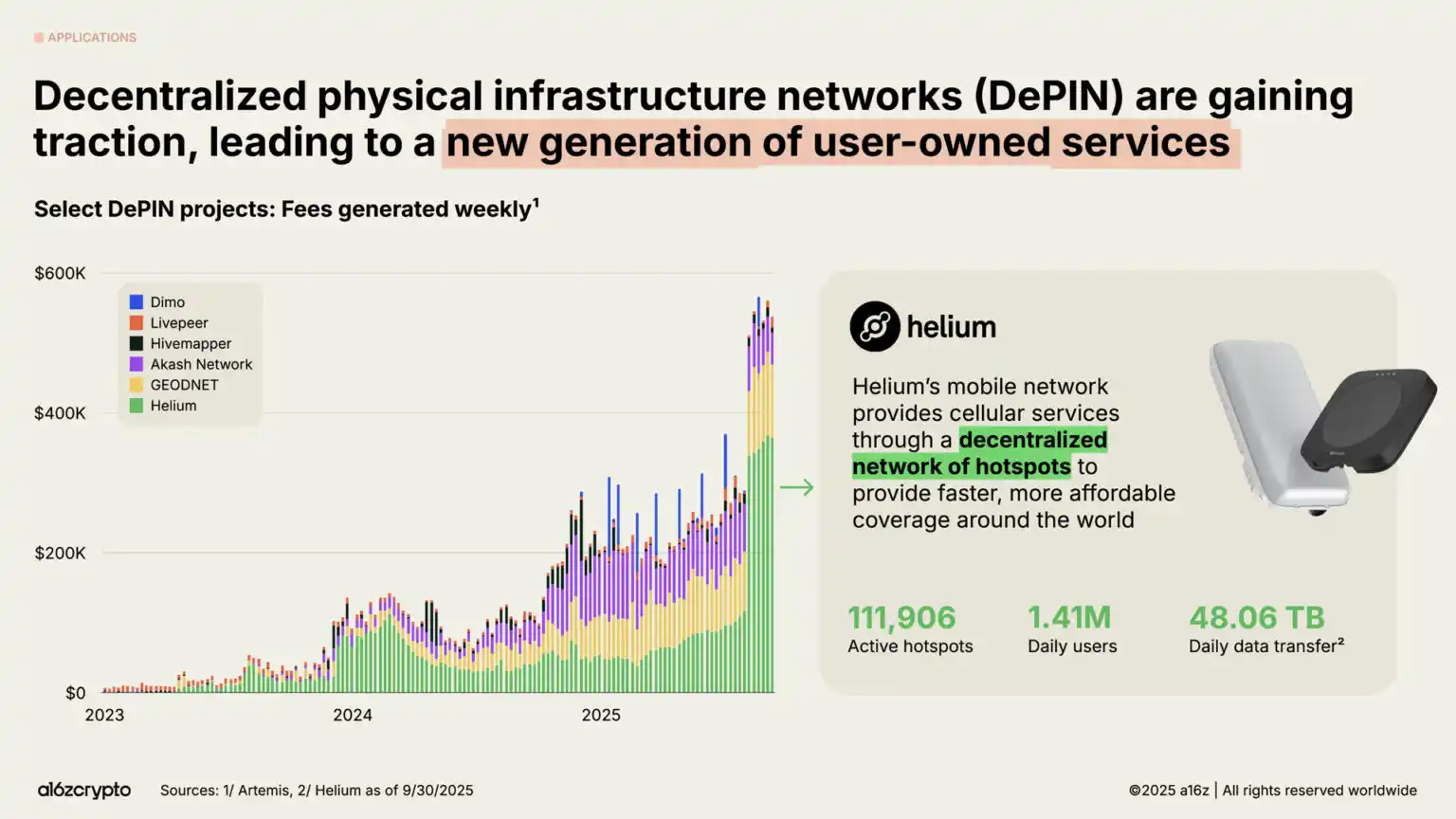
Prediction markets broke into the mainstream during the 2024 U.S. presidential election cycle, with leading platforms Polymarket and Kalshi reaching monthly trading volumes of several billion dollars. Despite previous doubts about whether activity could be maintained in non-election years, these platforms have seen trading volume grow nearly fivefold since early 2025, approaching historical highs.
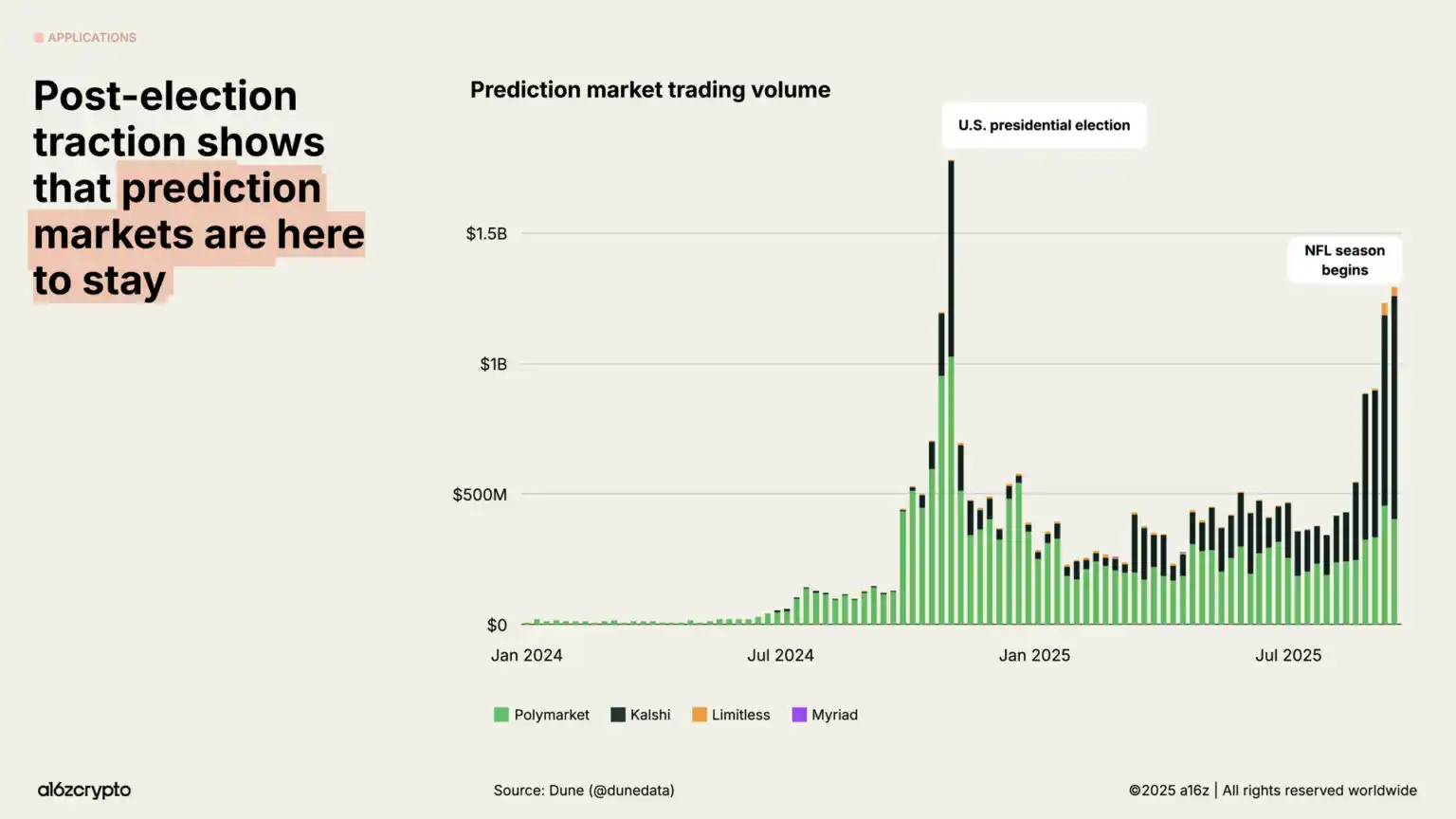
In the absence of clear regulation, memecoins have exploded, with over 13 million launched in the past year. As sound policies and bipartisan legislation clear the way for more constructive blockchain use cases, this trend has cooled in recent months—issuance in September was down 56% from January.
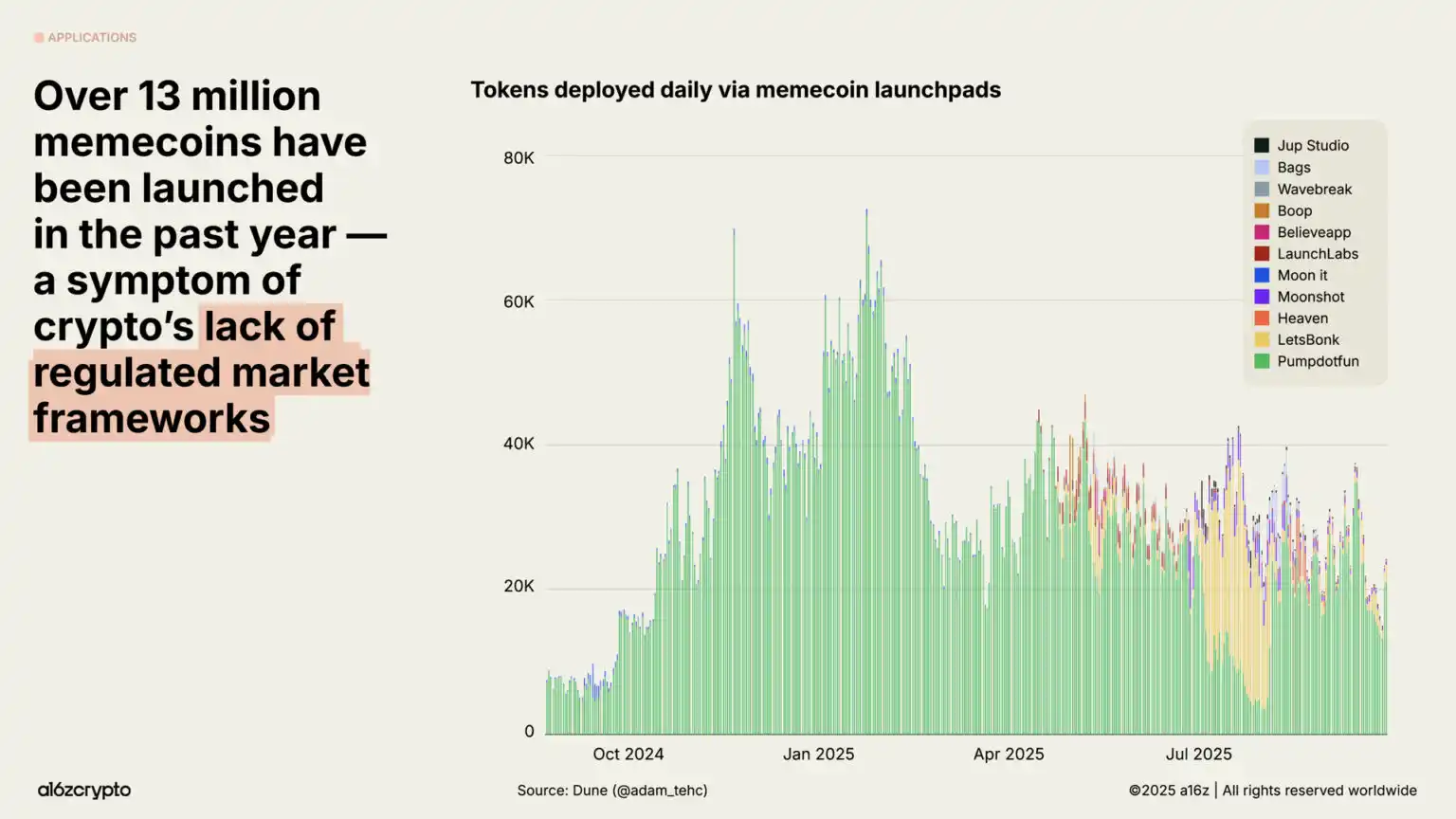
Although NFT market trading volume has not returned to its 2022 peak, the number of monthly active buyers continues to grow. These trends suggest consumer behavior is shifting from speculation to collecting, with lower on-chain space costs on Solana, Base, and other chains enabling this shift.
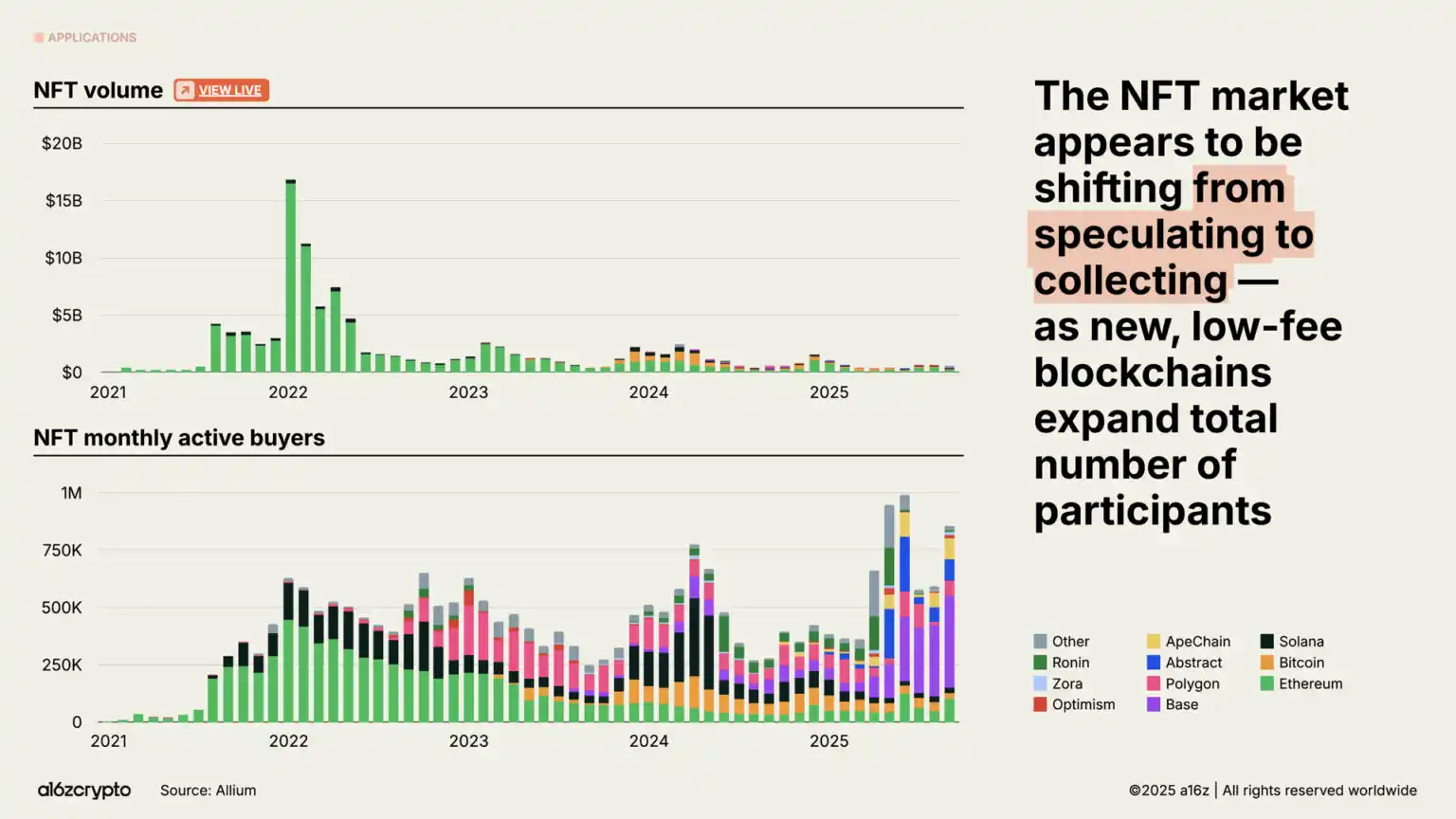
6. Blockchain Infrastructure Is Approaching a Maturity Tipping Point
None of these activities would be possible without major advances in blockchain infrastructure.
In just five years, the total transaction throughput of mainstream blockchain networks has increased more than 100-fold. In the past, blockchains processed fewer than 25 transactions per second; today, they handle 3,400 transactions per second, on par with Nasdaq’s trading speed and Stripe’s global processing volume during Black Friday, at only a fraction of the historical cost.
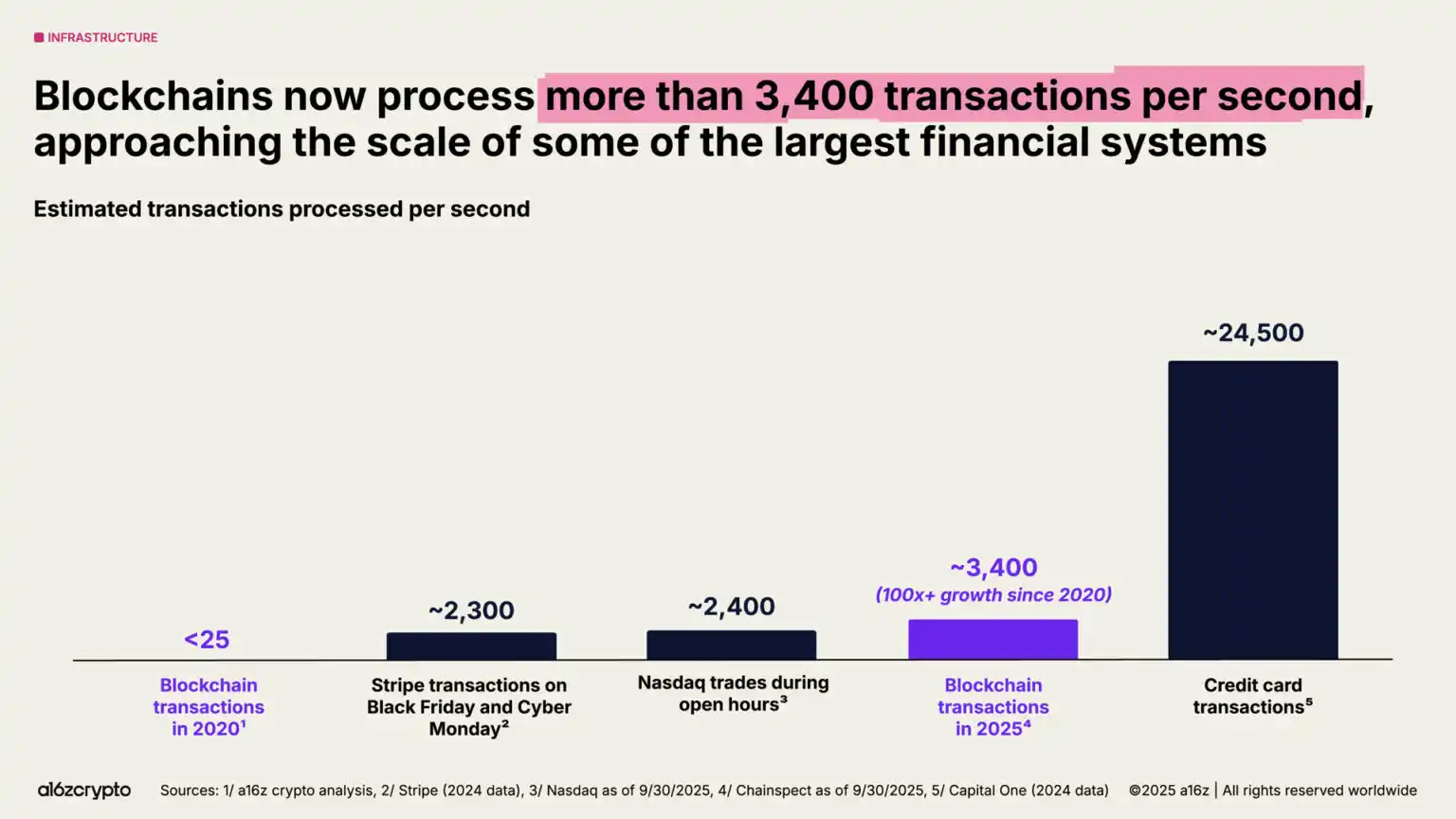
Within the blockchain ecosystem, Solana has become one of the most prominent representatives. Its high-performance, low-fee architecture now supports a wide range of applications from DePIN projects to NFT marketplaces, with its native applications generating $3 billion in revenue over the past year. Planned upgrades are expected to double the network’s capacity by year-end.
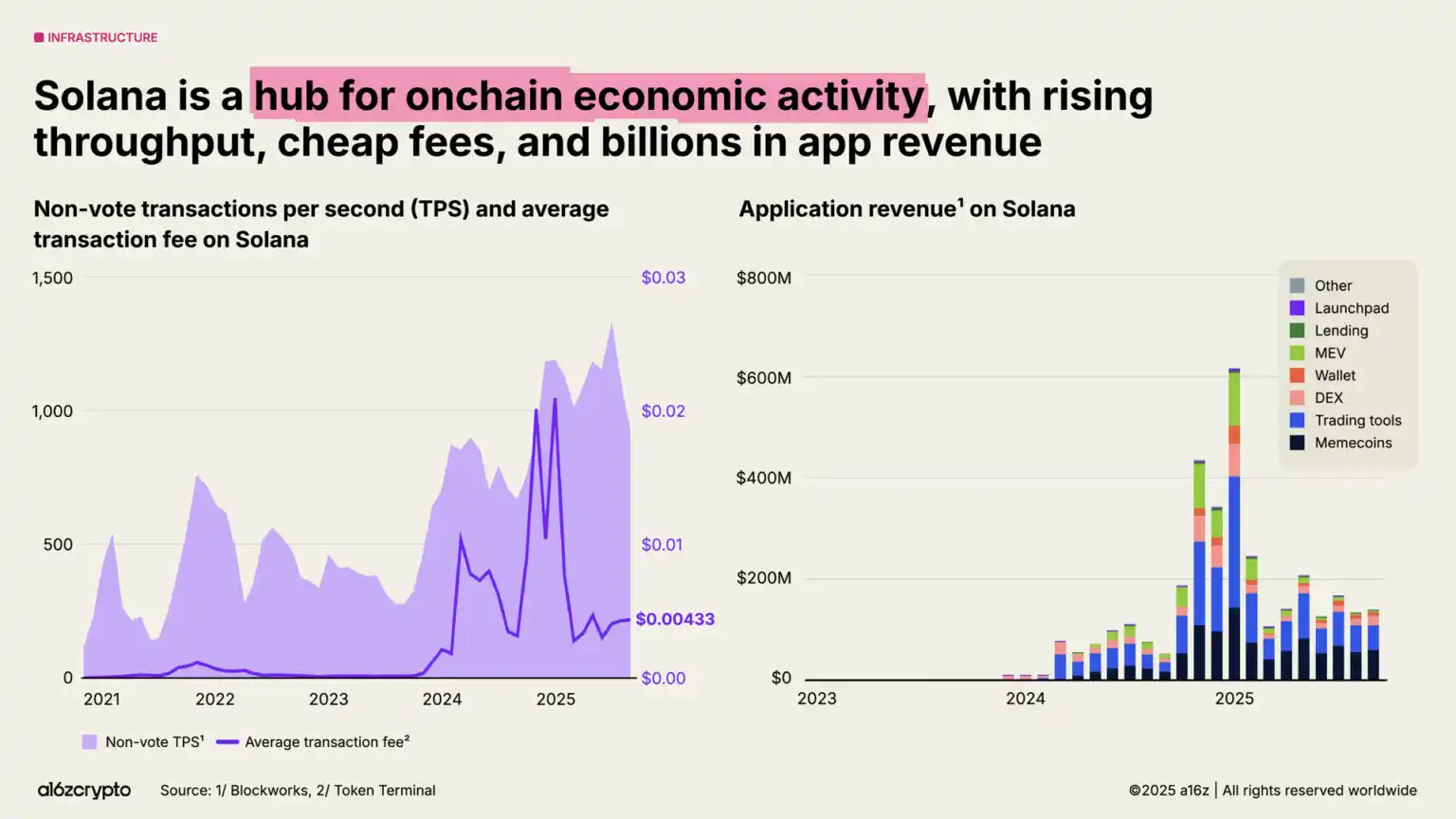
Ethereum continues to advance its scaling roadmap, with most economic activity having migrated to Layer 2 solutions such as Arbitrum, Base, and Optimism. The average transaction cost on L2s has dropped from about $24 in 2021 to less than a cent today, making Ethereum-related block space both cheap and abundant.
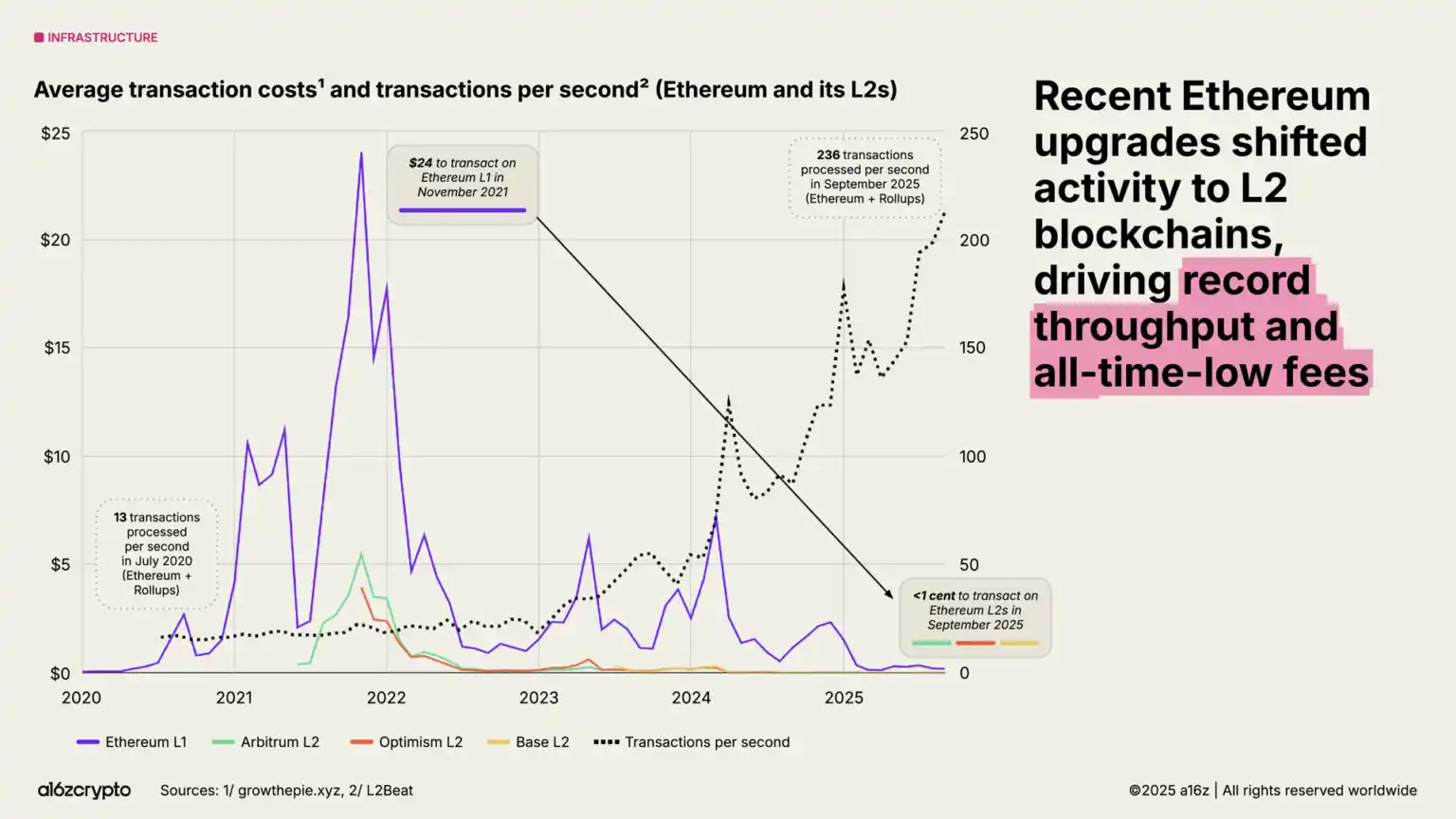
Cross-chain bridges are enabling blockchain interoperability. Solutions such as LayerZero and Circle’s cross-chain transfer protocol allow users to move assets across multi-chain systems. Hyperliquid’s canonical bridge has processed $74 billion in transactions so far this year.
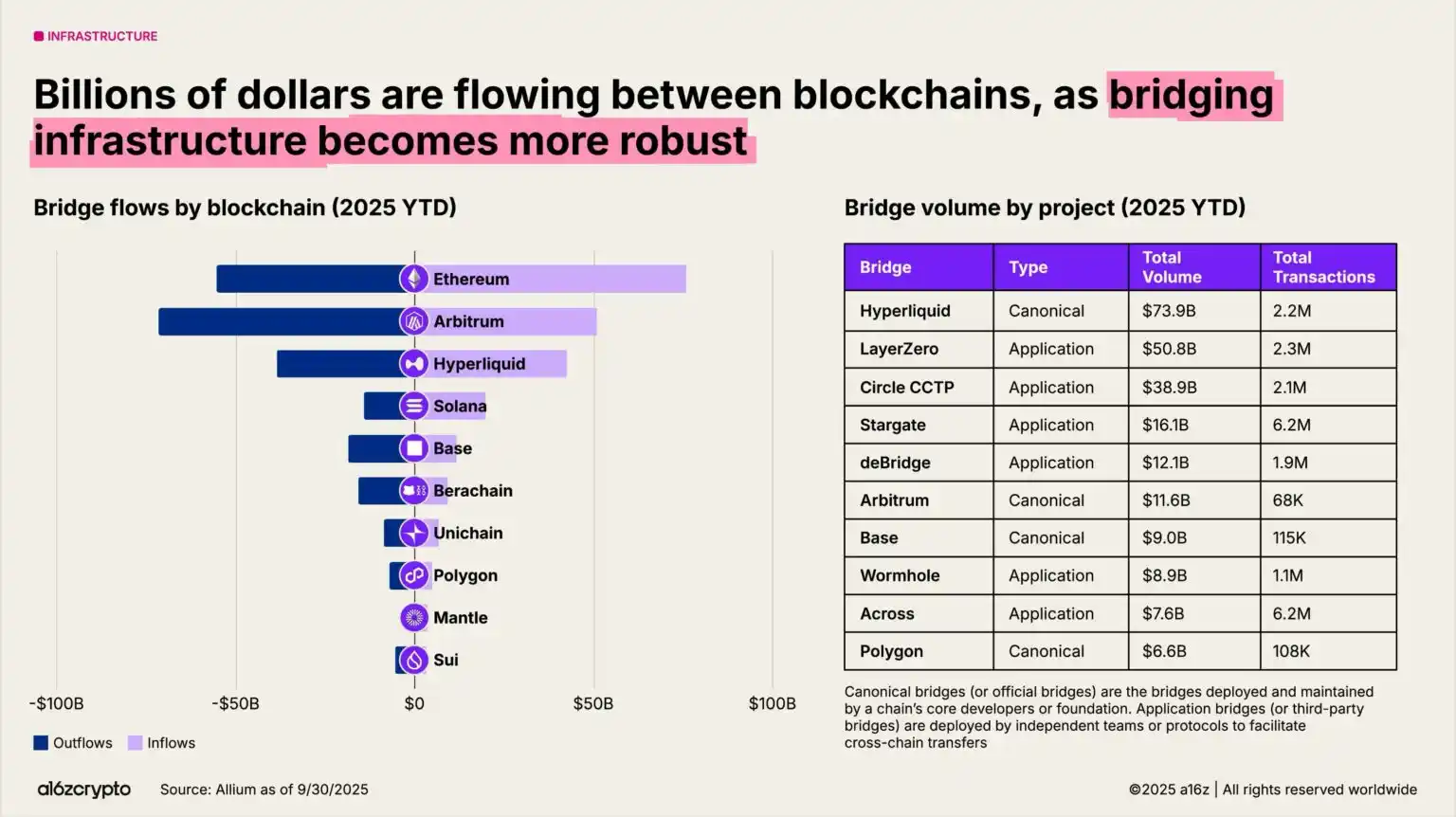
Privacy protection is returning to the spotlight and may become a prerequisite for mass adoption. Signs of rising attention include: a surge in Google searches related to crypto privacy in 2025; Zcash’s shielded pool supply growing to nearly 4 million ZEC; and Railgun’s monthly transaction volume exceeding $200 million.
More signs of momentum: the Ethereum Foundation has established a new privacy team; Paxos and Aleo have launched a private and compliant stablecoin (USAD); and the Office of Foreign Assets Control has lifted sanctions on the decentralized privacy protocol Tornado Cash. We expect this trend to gain further momentum in the coming years as crypto technology continues to go mainstream.
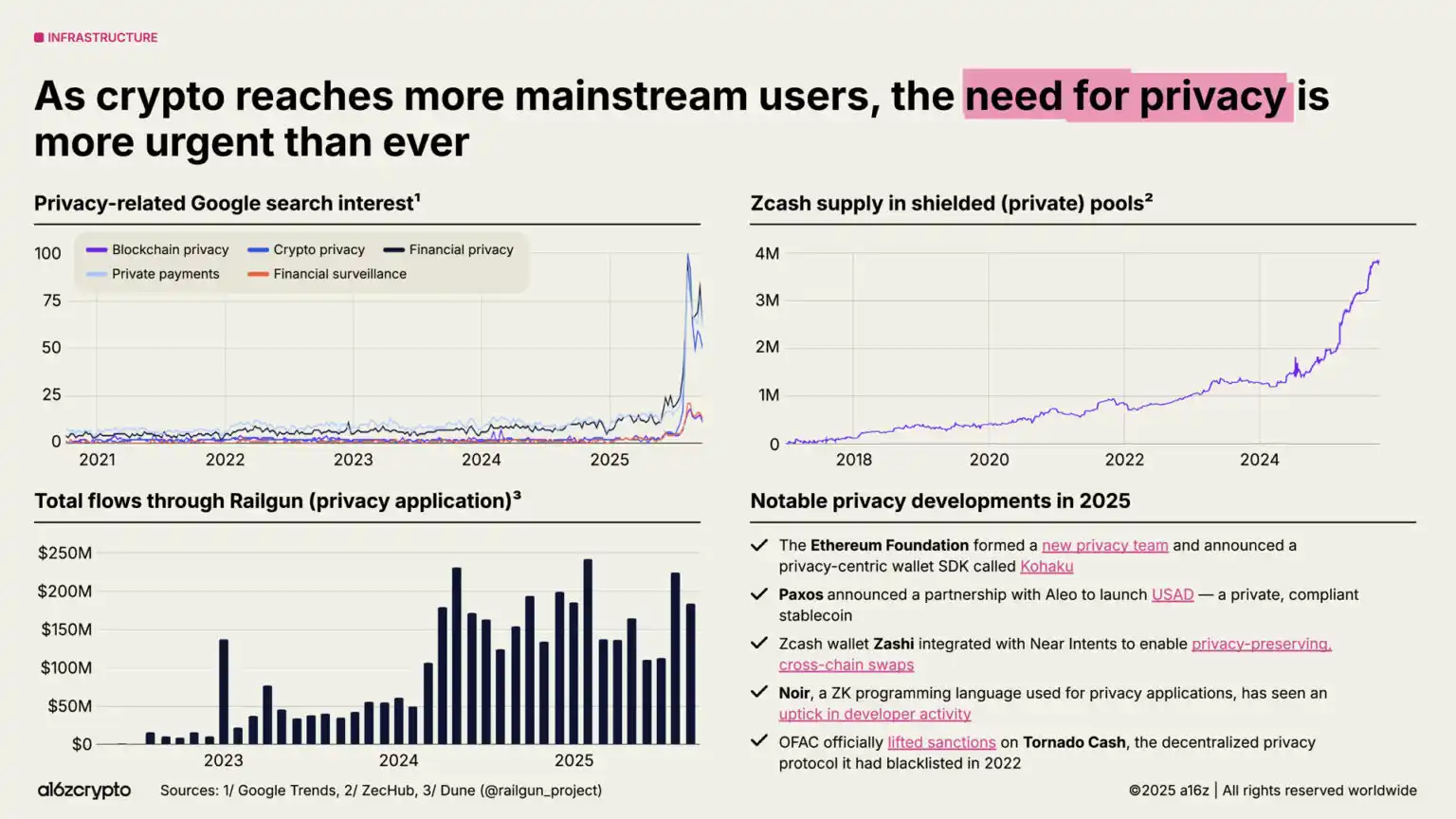
Similarly, zero-knowledge proofs and succinct proof systems are rapidly evolving from decades of academic research into critical infrastructure. Zero-knowledge systems are now integrated into rollups, compliance tools, and even mainstream web services—Google’s newly launched ZK identity system is one example.
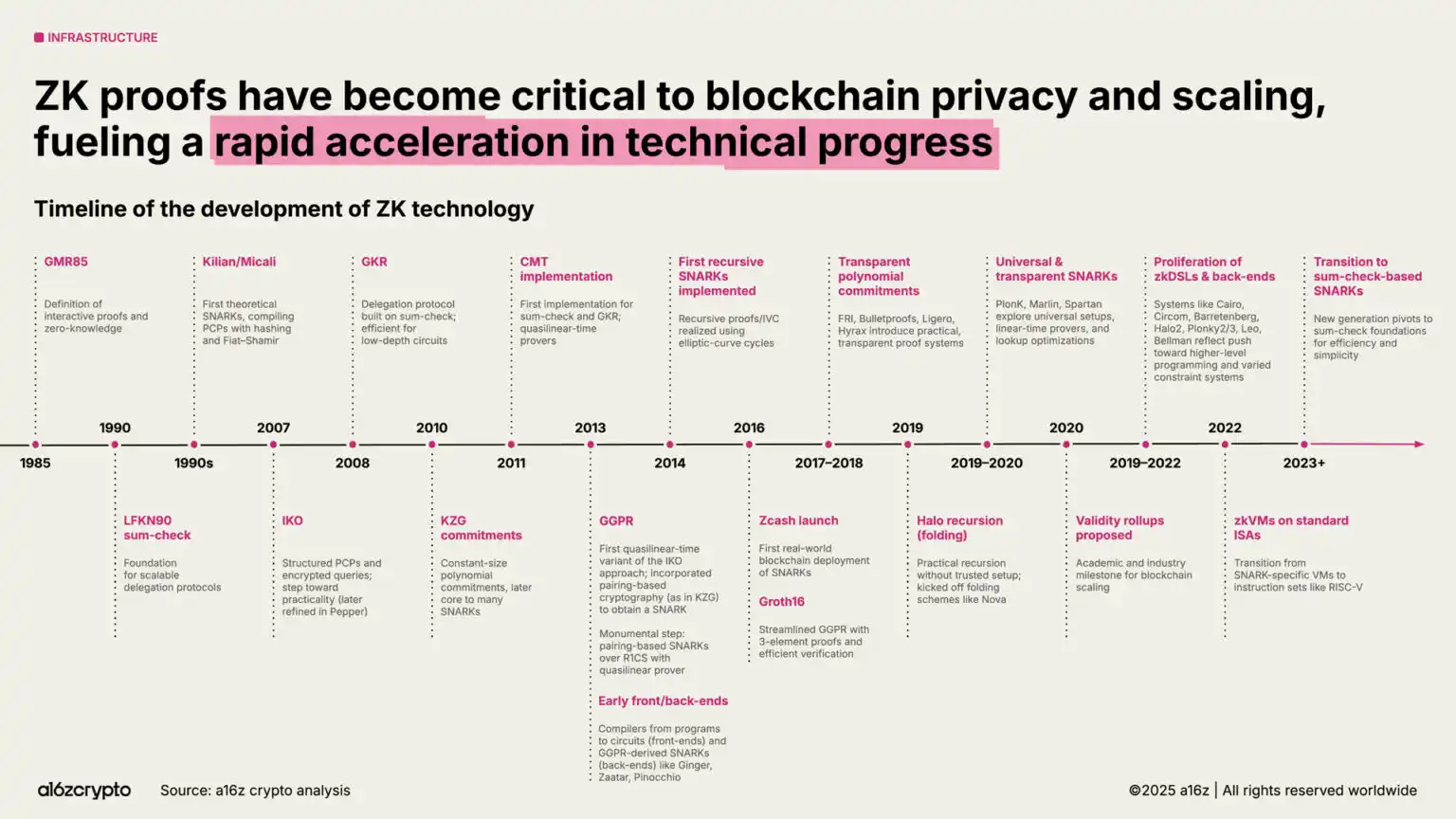
Meanwhile, blockchains are accelerating their post-quantum roadmap. Currently, about $750 billion in Bitcoin is stored in addresses vulnerable to future quantum attacks. The U.S. government plans to transition federal systems to post-quantum cryptography by 2035.
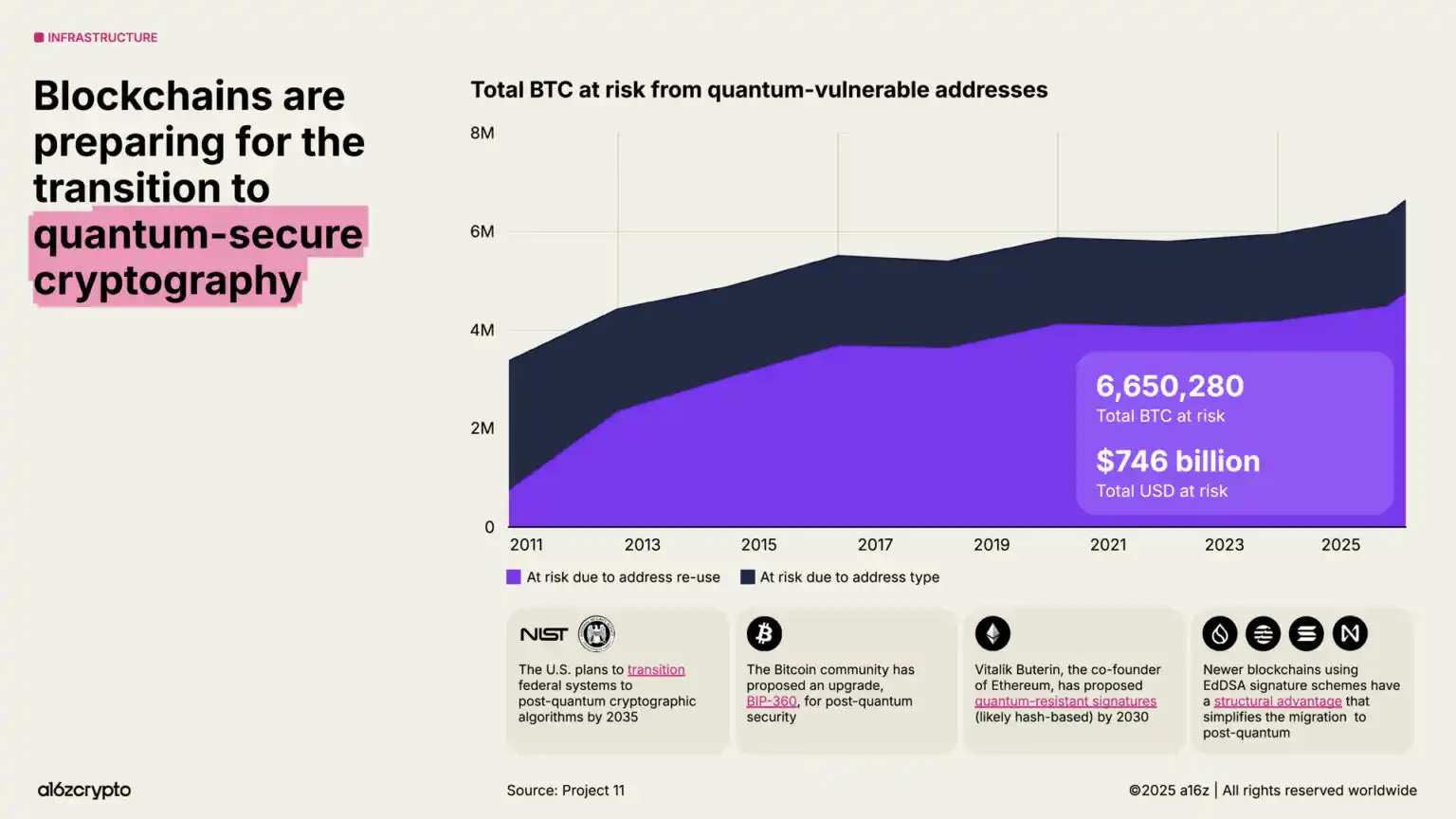
7. Deep Integration of Crypto and Artificial Intelligence Technologies
Among many technological advances, the launch of ChatGPT in 2022 brought AI into the public spotlight—creating clear opportunities for crypto. From provenance and IP licensing to providing payment channels for agents, crypto technology may be the answer to some of AI’s most pressing challenges.
Decentralized identity systems such as Worldcoin, which has verified over 17 million users, can provide "proof of humanity" and help distinguish real users from bots.
Emerging protocol standards like x402 are becoming potential financial infrastructure for autonomous AI agents, helping them complete micropayments, API calls, and intermediary-free settlements—Gartner predicts the scale of such an economy could reach $30 trillion by 2030.
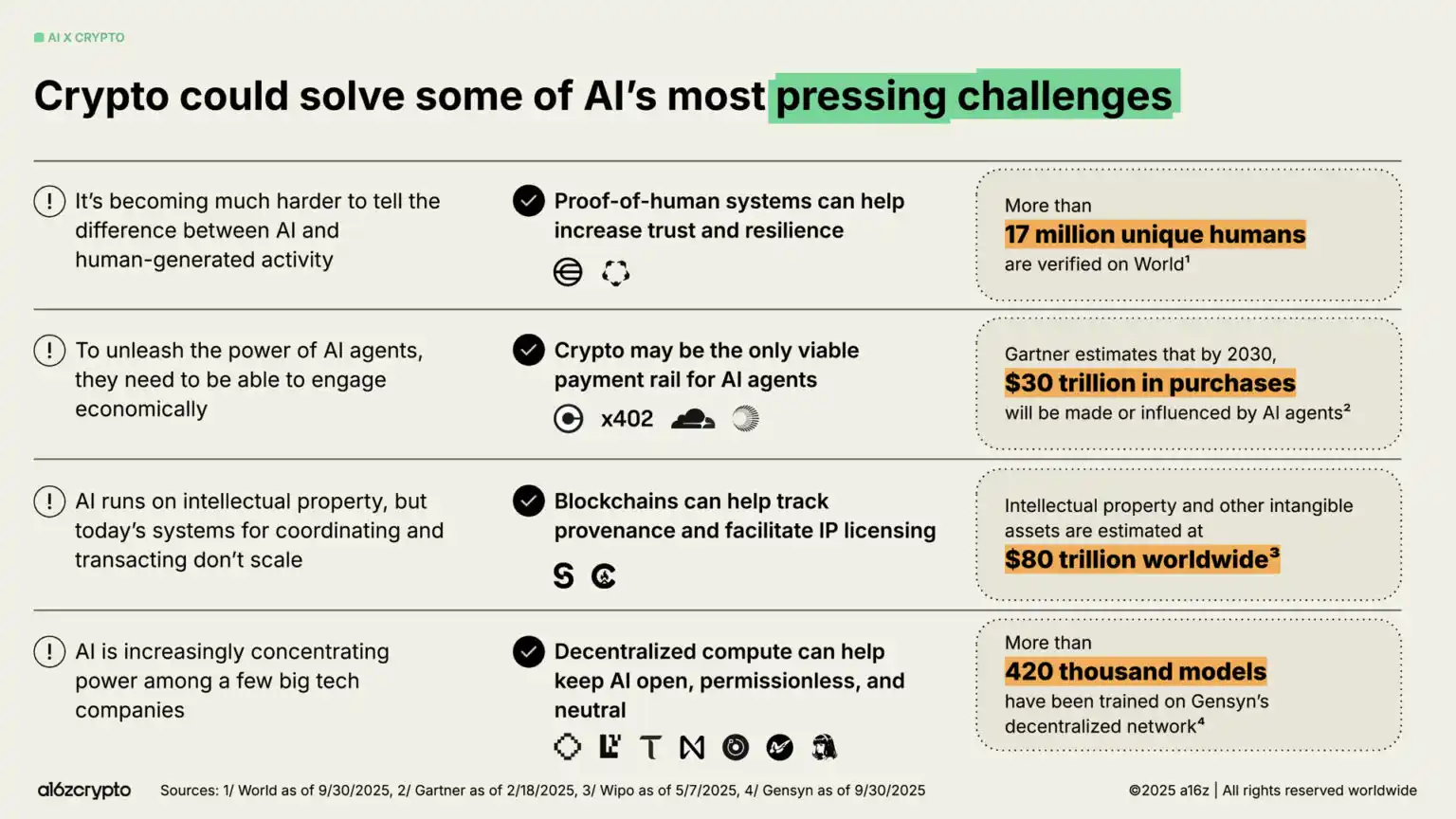
Meanwhile, the compute layer for AI is consolidating around a handful of tech giants, raising concerns about centralization and censorship. Currently, just OpenAI and Anthropic control 88% of "AI-native" enterprise revenue, Amazon, Microsoft, and Google account for 63% of the cloud infrastructure market, and Nvidia holds 94% of the data center GPU market. This imbalance has allowed the "Magnificent Seven" to achieve double-digit net profit growth for consecutive quarters, while the other 493 S&P 500 companies have not outpaced inflation in aggregate earnings growth.
Blockchain technology provides a counterbalance to the centralizing forces emerging in AI systems.
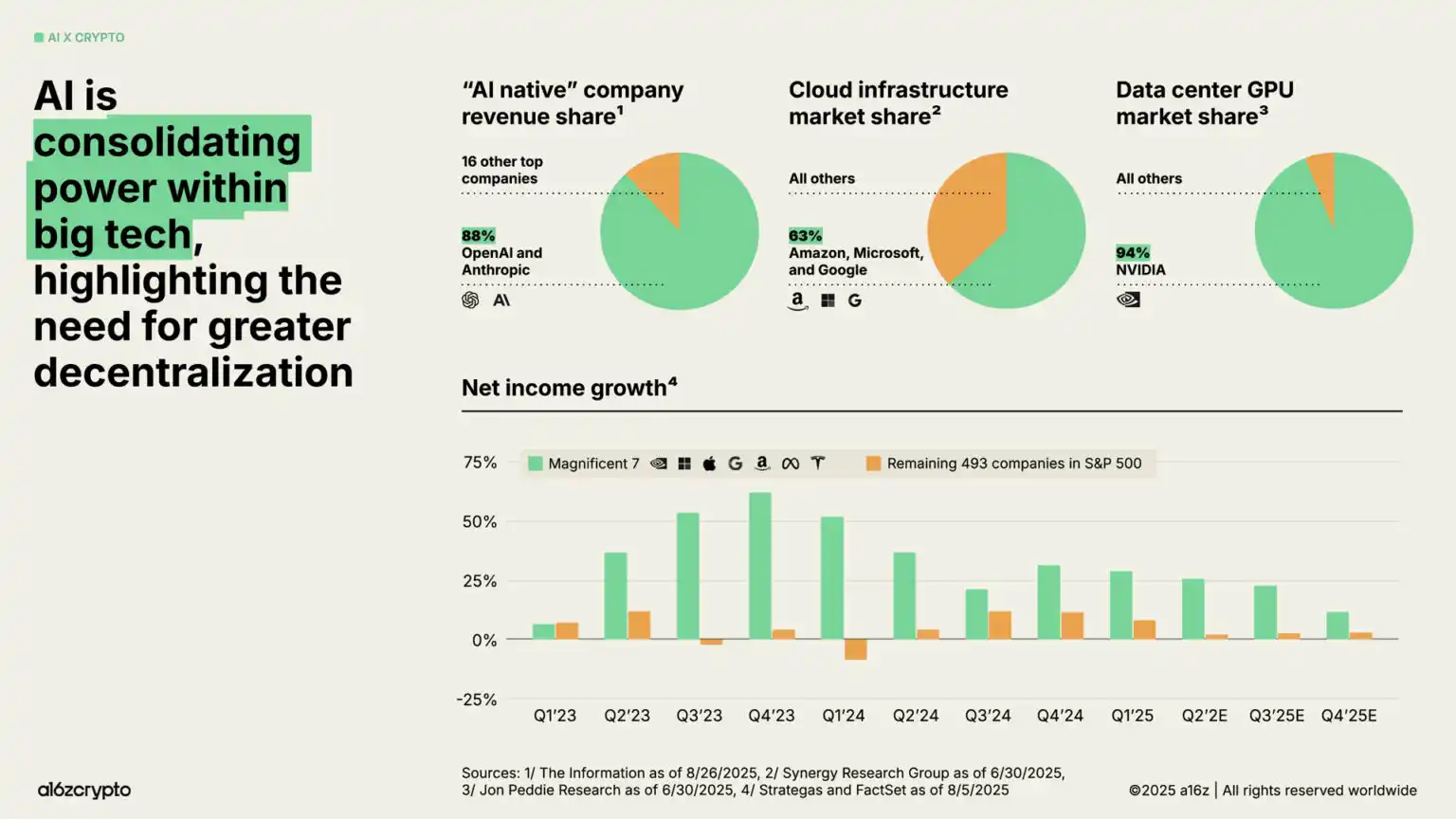
Amid the AI boom, some crypto builders have shifted focus. Our analysis shows that since the launch of ChatGPT, about 1,000 jobs have moved from the crypto industry to AI. However, this outflow has been offset by an equal number of builders joining crypto from traditional finance, tech, and other sectors.
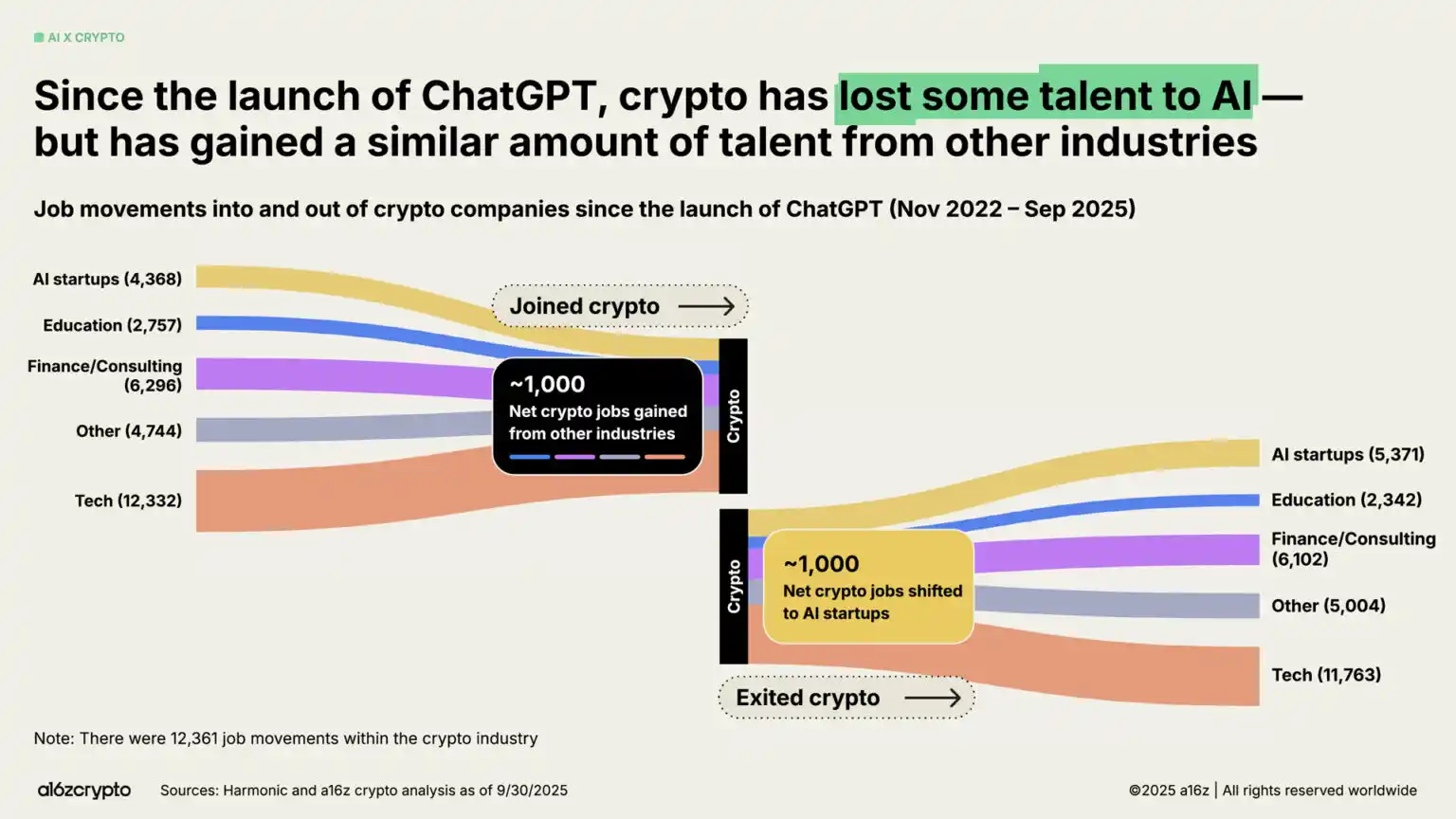
8. Outlook
Where are we now? As regulatory frameworks become clearer, the path for tokens to generate real revenue through fees is becoming more defined. The adoption of crypto by traditional finance and fintech will continue to accelerate; stablecoins will upgrade the traditional financial system and drive global financial inclusion; new products will lead the next wave of users into the on-chain world.
We already have the infrastructure and distribution networks, and regulatory certainty to mainstream the technology may soon follow. Now is the time to upgrade the financial system, rebuild global payment rails, and construct the ideal form of the internet.
After seventeen years of development, the crypto industry is leaving adolescence behind and entering maturity.
Disclaimer: The content of this article solely reflects the author's opinion and does not represent the platform in any capacity. This article is not intended to serve as a reference for making investment decisions.
You may also like
Bitcoin falls below $87,000 as cryptocurrency weakness intensifies
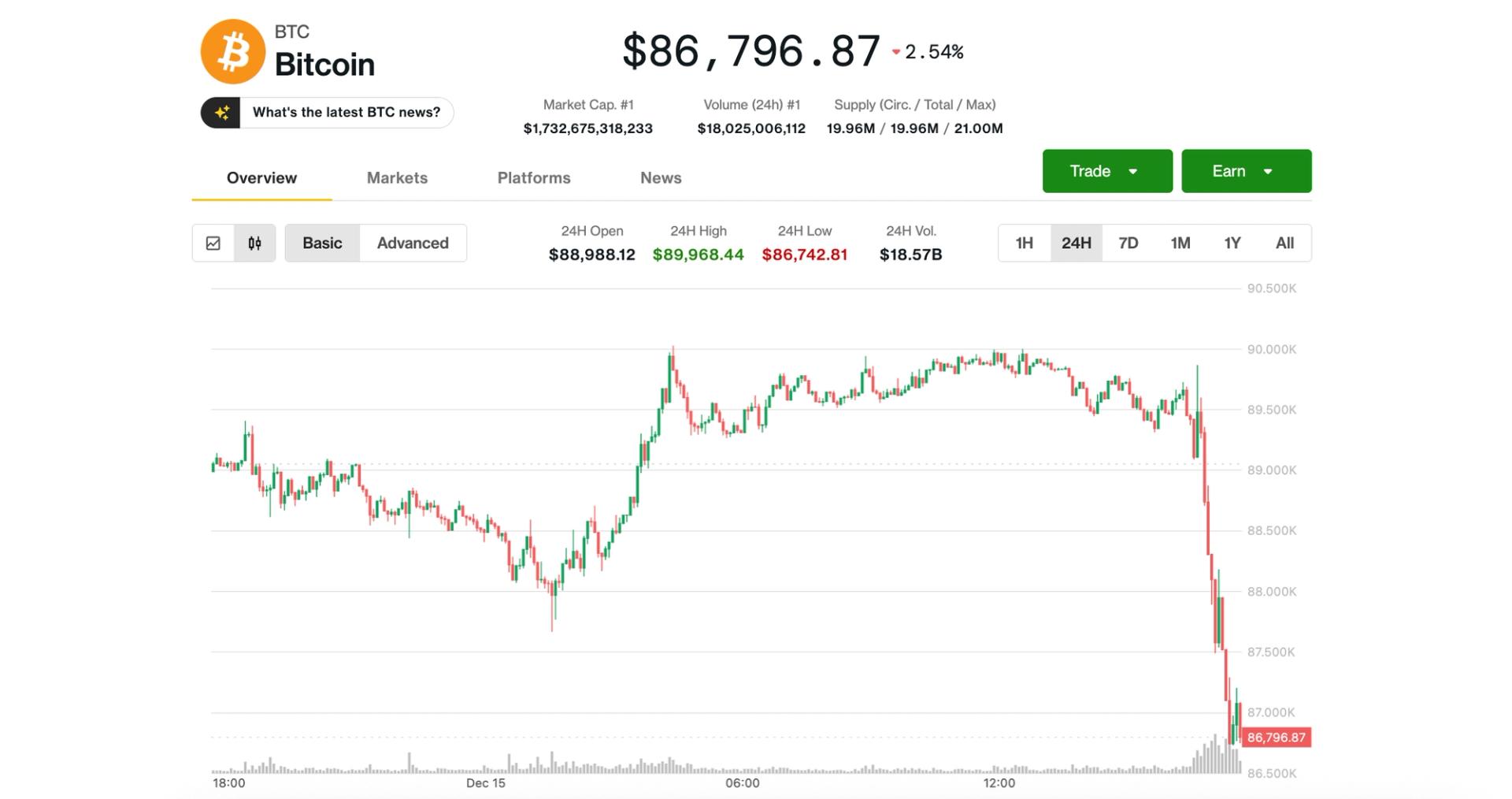
Bitcoin, altcoins sell-off as Fed chair switch-up, AI bubble fears spook markets

From yen rate hikes to mining farms shutting down, why is bitcoin still falling?
The recent decline in bitcoin prices is primarily driven by expectations of a rate hike by the Bank of Japan, uncertainty regarding the US Federal Reserve's rate cut trajectory, and systemic de-risking by market participants. Japan's potential rate hike may trigger the unwinding of global arbitrage trades, leading to a sell-off in risk assets. At the same time, increased uncertainty over US rate cuts has intensified market volatility. In addition, selling by long-term holders, miners, and market makers has further amplified the price drop. Summary generated by Mars AI This summary was generated by the Mars AI model, and the accuracy and completeness of its content are still being iteratively updated.

